Outforia Quicktake: Key Takeaways
- Always accurately identify mushrooms before consumption, as some poisonous ones look similar to edible ones.
- Consult a reliable field guide, an experienced forager, or your local health authorities to help with proper identification.
- Identifying mushrooms involves examining habitat, substrate, nearby trees, cap shape, diameter, height, color, texture, smell, and spore print.
- Spore prints can be taken by leaving a mature, opened cap of the mushroom in a sheltered dark space overnight on plain colored paper.
- Careful identification and knowledge are essential before consumption. Be very cautious when foraging for mushrooms; some can be highly toxic. If you are anything less than 100% certain of any given mushroom’s identity or have any doubts about its safety, do not consume it.
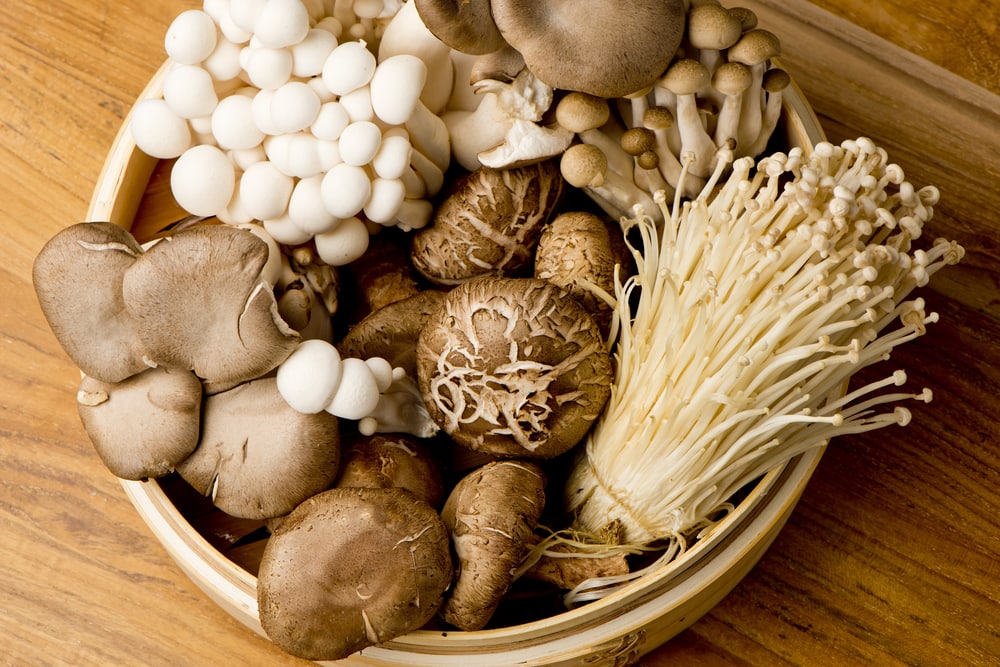
In damp ground and rotting matter, you can always find mushrooms – a class of life neither animal or plant. They don’t move, but they don’t photosynthesize either. Mushrooms are in a special weird bracket of their own!
They are eukaryotic, non-vascular, non-motile and heterotrophic. In simpler terms, this means:
- Eukaryote: they have cells with a nucleus.
- Non-vascular: they don’t have tubes to transport nutrients.
- Non-motile: they don’t move.
- Heterotrophic: they need to take food from their environment instead of manufacturing their own food, like plants.
There are so many types of edible mushrooms that it’s impossible to list them all, but here are 40 tasty examples. And remember – despite how appetizing they may be, it’s always best to cook mushrooms before eating them!
You May Also Like: Discover The Art Of Foraging: What Is Foraging And How Can It Benefit You?
1. Cep Mushroom (Penny Bun) – Boletus edulis
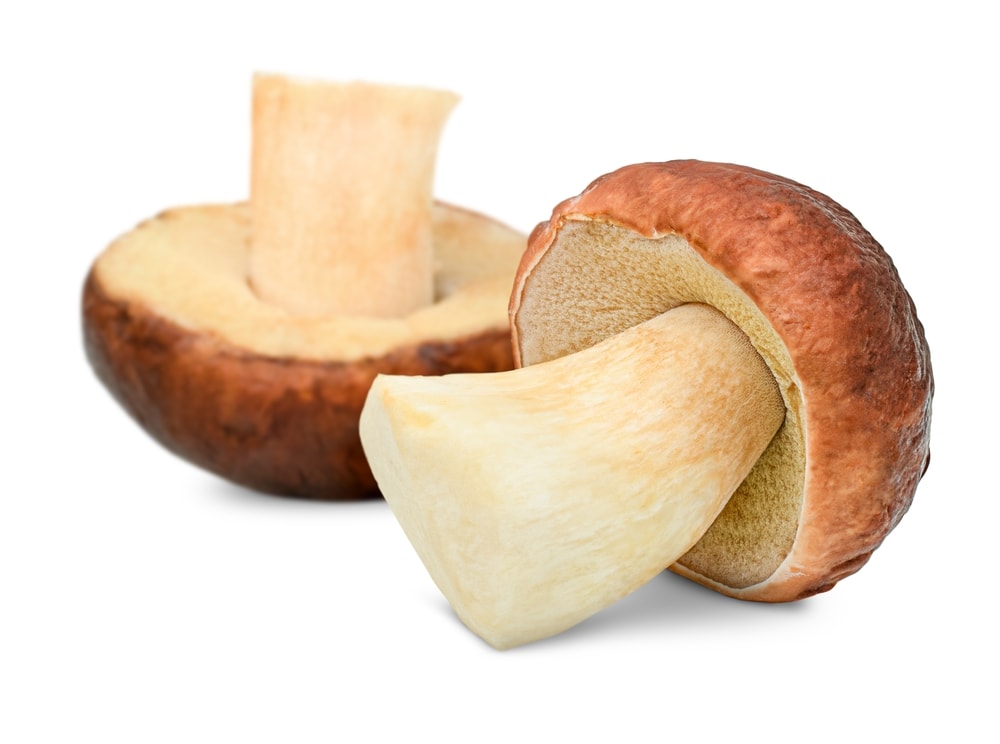
The Cep is beloved by chefs everywhere.
It is large, with a chunky cap and thick stem. It looks like a nice crusty bread roll, hence the name! It’s in the Bolete family, which means if you look underneath the cap you will see lots of tiny holes instead of gills.
The Edulis in its scientific name means edible. It is called Porcini in Italy and Steinpiltz in Germany. There are many variations of the Cep in North American forests, where it’s known as the King Bolete. The French call it bouchon – meaning “champagne cork”!
It’s found under birch, beech, Scots pine, and spruce trees. The Cep helps trees it lives under by breaking down nutrients for the tree.
You can dry older specimens and use them as stock to flavor dishes like soups and stews. Cook them in a cream sauce and pour over tagliatelle pasta or eat them sliced thinly and raw in a salad.
2. Field Parasol – Macrolepiota procera
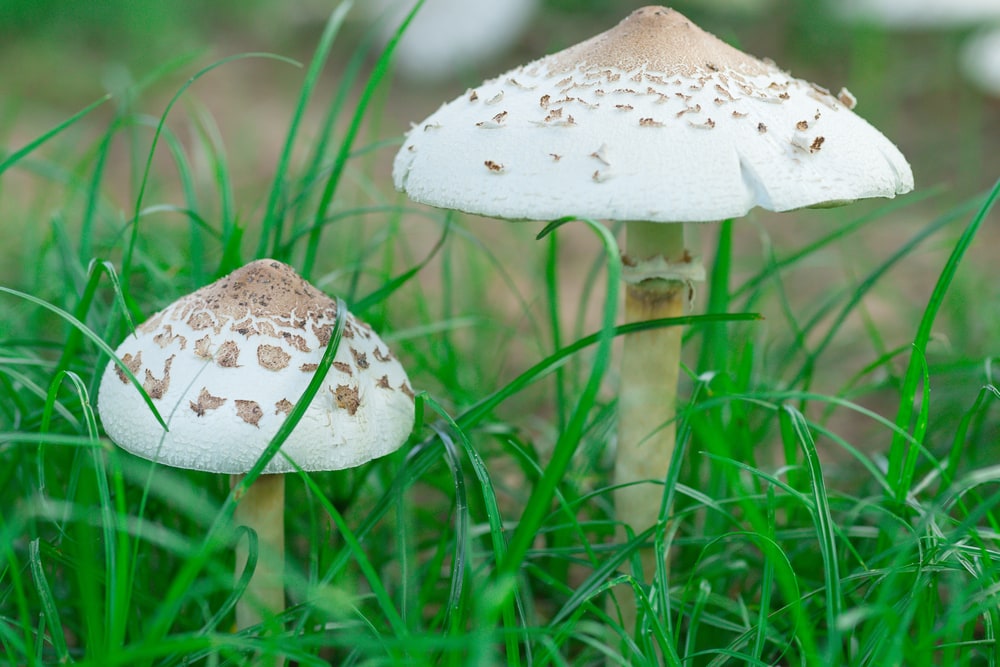
Field Parasol is a delicious edible which is very easy to recognize. It has a delicate nutty taste. It’s found in the US, Europe, and the UK. I often find it on grassland and in horse fields.
It’s tall and has dry scales on the top of the cap. There is a snakeskin pattern on the long stem. The gills are creamy white and crowded. It also has a dry, leathery texture, like skin.
My favorite way to eat it is fried with butter and garlic, then placed on rye bread toast. You can also make them into a Parasol Schnitzel by dipping them in egg and then breadcrumbs.
3. Fairy Ring Champignon – Marasmius oreades
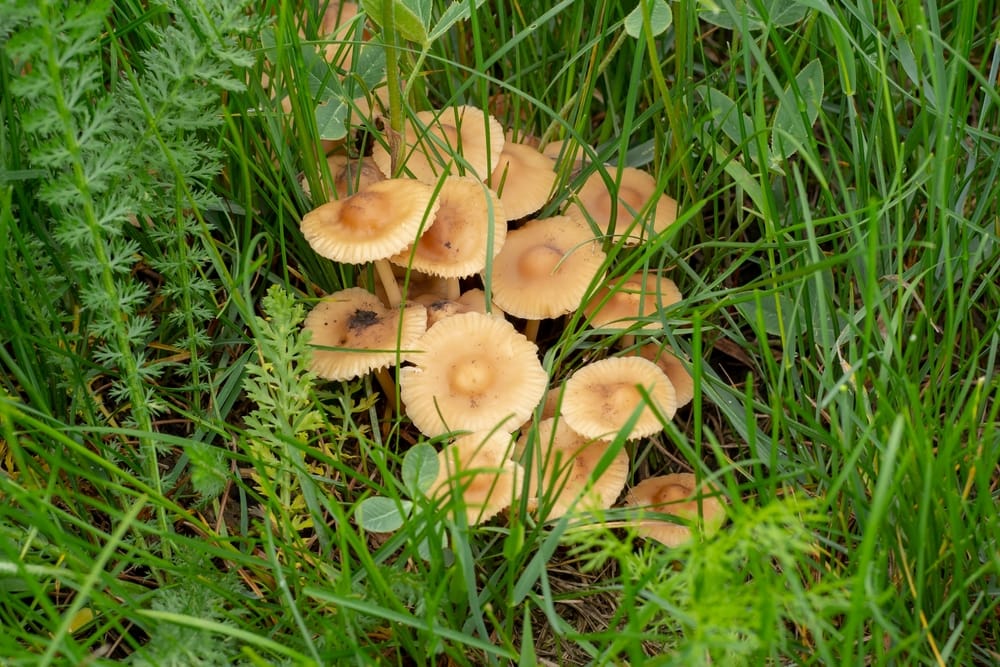
These little mushrooms grow in “fairy rings” in short grass – I always find them on golf courses! Parks, village greens and sports pitches are also likely places.
The bigger the ring, the older the underground part of the mushroom is. It spreads outwards every year, like rings on a tree.
They are easy to dry and store for later use in soups and stews. They also smell like roast dinner! You can easily rehydrate them and they’re as tasty as before you dried them.
Fairy Ring Champignons have a poisonous lookalike – the Ivory Clitocybe (Clitocybe dealbata). You can tell them apart by the cap shape and the gills.
The Ivory Clitocybe has an irregular, wavy-shaped cap. Its gills are crowded together and are usually whiter in color.
The Fairy Ring Champignon has widely spaced gills that have a pattern of long and short gills around the underside of the cap.
4. Clouded Agaric – Clitocybe nebularis
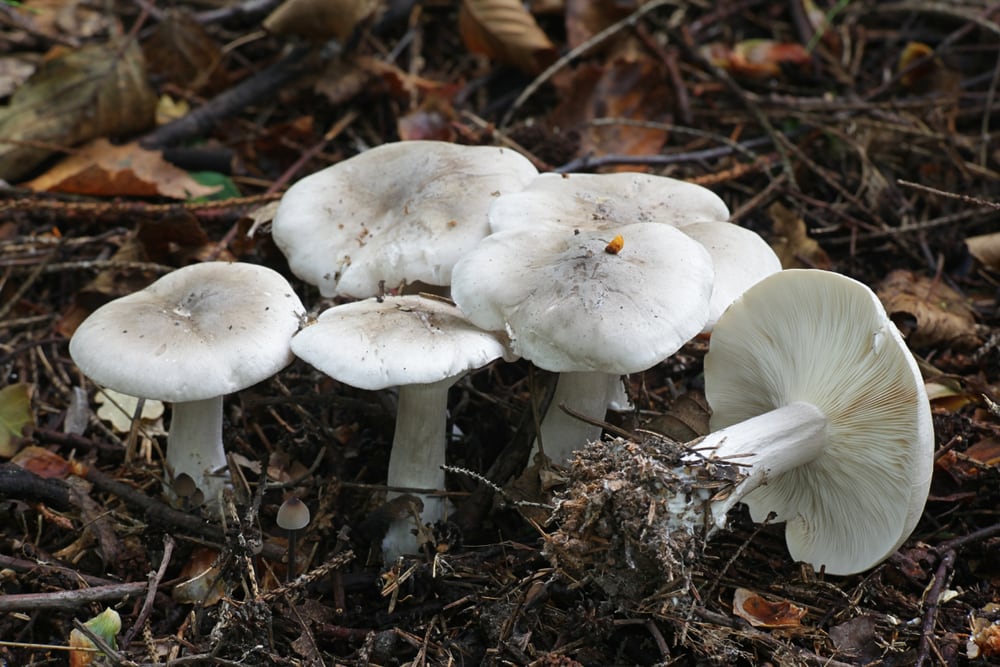
This substantial mushroom has a cap with soft grays leading into each other. It’s 20 cm (7.9 in) across and 12 cm (4.7 in) high. Just a few of these make enough food for a meal.
It has decurrent gills. This means it’s a funnel shape when you look at the underside, with the gills running down the stem.
Clouded Agaric is a good edible to 4/5 people but causes bad stomach aches and diarrhea to the rest. The only way to know if you are sensitive to this mushroom or not is to try a small piece and wait 24 hours.
Thankfully, I was one of the lucky ones! It has a nice firm white flesh and tasted lovely in a cream sauce with pasta and parsley.
5. Tawny Grisette – Amanita fulva
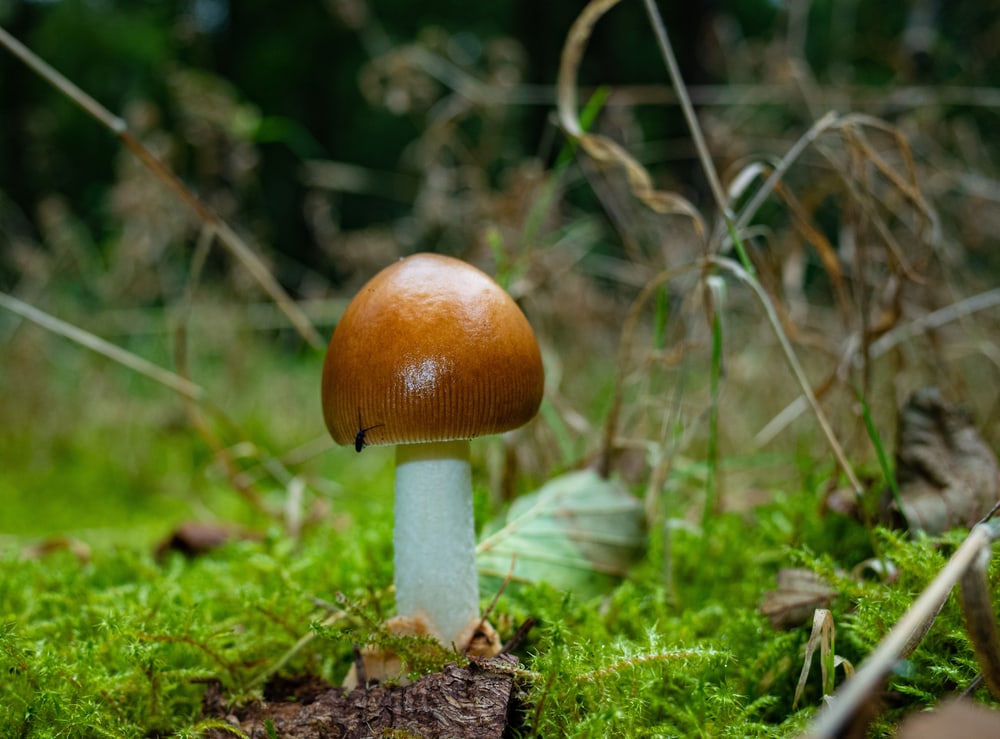
Tawny Grisette mushroom shares ancestry with the Death Cap and Destroying Angel. It shares some of the same characteristics – it grows out of a volva, which is a bag-like sac at its base. It also has crowded white gills.
Its cap is an autumnal orange, but can fade to a umber color. The cap has striations around the edge, which are little lines all around the edge of the cap.
If you use your mushroom knife to slice this mushroom in half you will see the stem is hollow.
You need to cook this mushroom first before eating it. Try them battered in tempura or in a mushroom soup medley with other wild mushrooms.
6. Slippery Jack – Suillus luteus
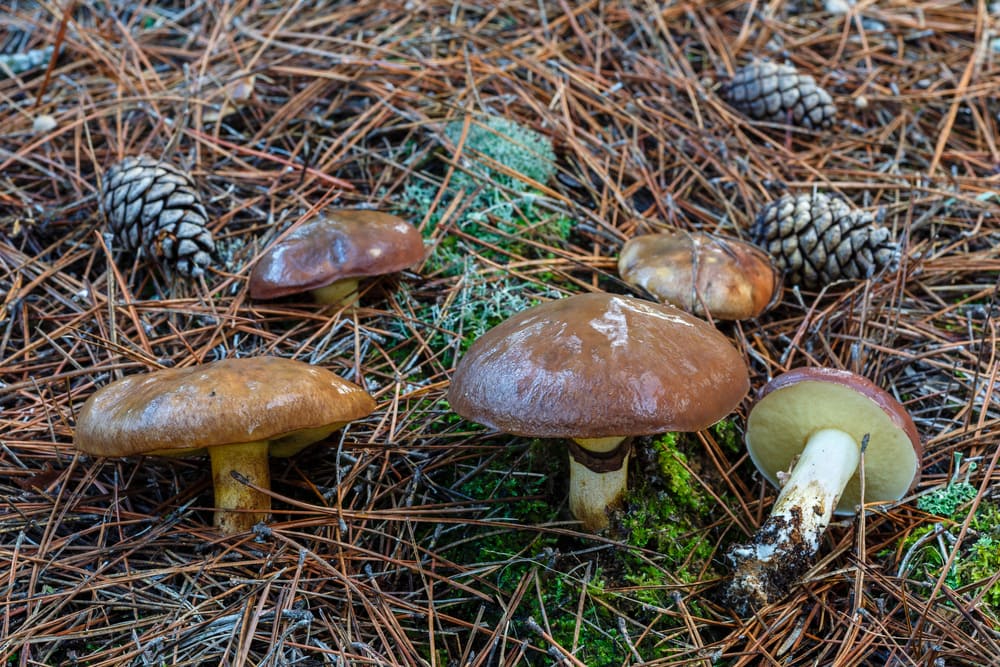
Slippery Jack has a slimy, shiny mucus over its cap but don’t be put off! It’s still a nice edible once you peel it.
Yes, you need to peel the slimy top layer off and scrape off the pores underneath. Once that’s over, you’re left with the edible part.
Here’s a video showing how to do this.
I’ve eaten Slippery Jack in mixed dried mushroom pots from the supermarket! It’s a pretty well known edible Bolete. Most Boletes, such as the Slippery Jack, have pores instead of gills.
7. Stinkhorn – Phallus impudicus
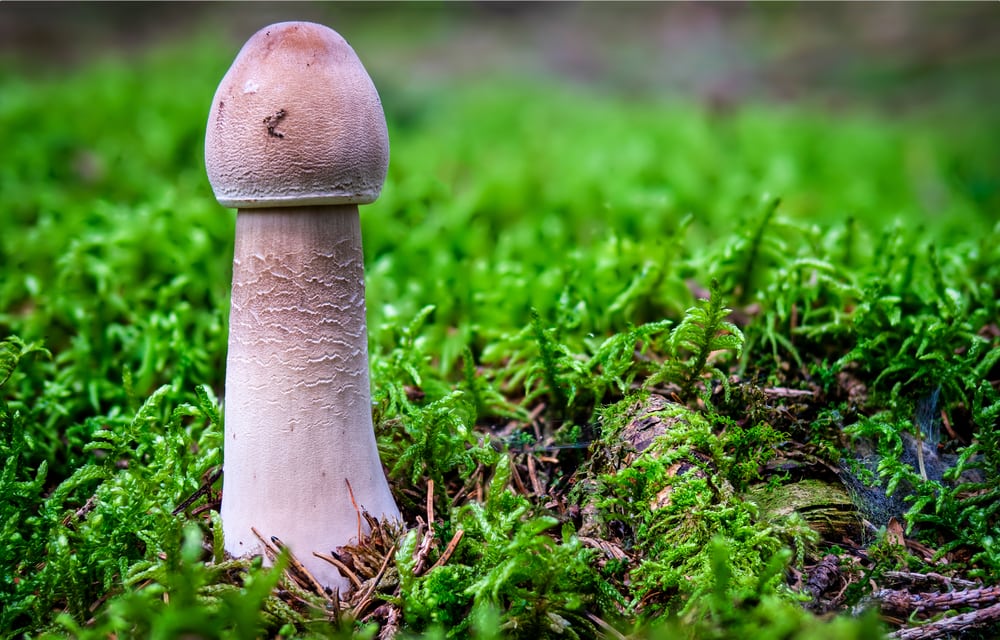
This fungus looks like a naughty part of a man. Its scientific name translates to “impudent phallus.” Coincidentally, the Dog Stinkhorn looks like a naughty part of a dog!
It has a long pale stem – which is called a stipe – and a dark brown closely-fitting cap.
In Victorian times, the shape of this mushroom was deemed so embarrassing, it was collected and burned. They went to such lengths in fear of young ladies’ morals being tainted at the sight of the mushroom.
As the name says, this mushroom stinks. It produces a feces-like scent and attracts blowflies, which drink the liquid on its cap. This liquid is full of the Stinkhorn’s spores. The flies land on some poop, and leave the spores there.
You can eat this mushroom in its egg form before it fruits, as it doesn’t start stinking until later. Just dig up the egg and cut out the inside – you’ll be surprised to know it’s as crisp as radish!
In France and Germany, it is sometimes added to sausages. It has also been ground up and eaten as an aphrodisiac.
8. Amethyst Deceiver – Laccaria amethystina
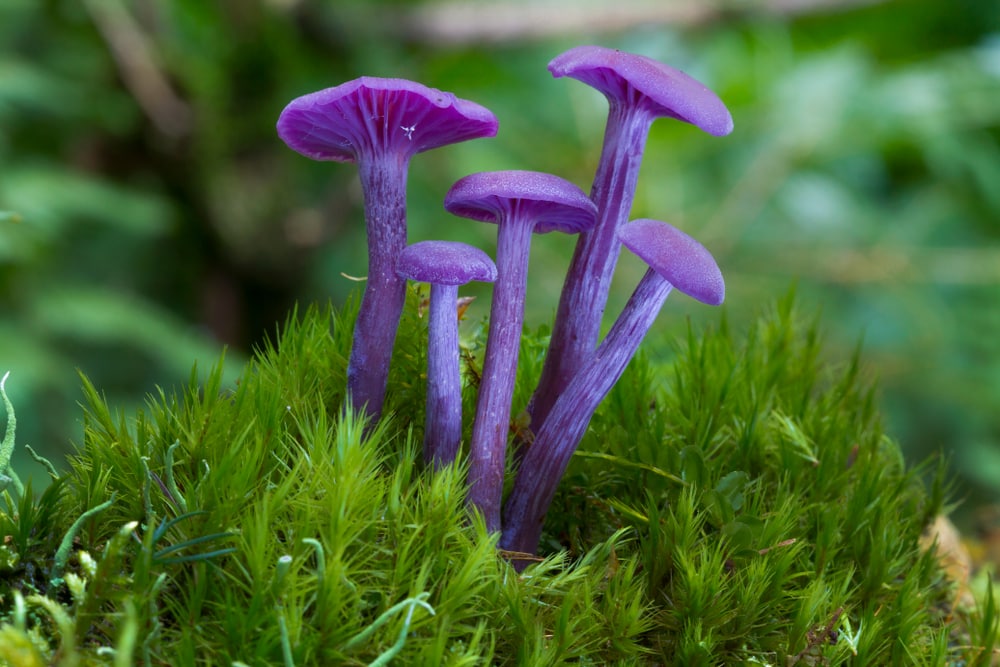
The beautiful Amethyst Deceiver sounds scary but, despite its deep purple color, it is edible.
It’s fairly small with a cap diameter of 1-6 cm (0.39 – 2.4 in) and a maximum height of 10 cm (3.9 in). You’d need to collect quite a few for a meal.
The gills are decurrent – which means it runs down the stem – and widely-spaced. If you look closely, you will see tiny white hairs on the Amethyst Deceiver. They are fibrous to the touch and don’t break easily.
I ate these in an Asian-style miso soup once. The color makes them stand out in a meal. They are surprisingly hard to spot on a woodland floor full of beech leaves.
Its lookalike, the Lilac Fibrecap, is poisonous.
9. Beefsteak Mushroom – Fistulina hepatica

This bracket fungus looks like a piece of raw meat sticking out of a tree trunk. It even bleeds red when cut! It’s also known as the Ox Tongue Fungus.
Its spores are pale pink and egg-shaped.
Beefsteak fungus is edible, but tastes bitter and acidic unless it is leached. Leaching means it should be cooked in water with the water thrown away afterwards.
I’ve eaten some and they have been quite palatable. But I’ve also eaten them in other areas, where they tasted sour.
Beefsteak mushroom causes oaks to have brown “tiger stripes” in their wood. This is sought after by furniture makers.
10. Giant Puffball – Langermannia / Calvatia gigantea
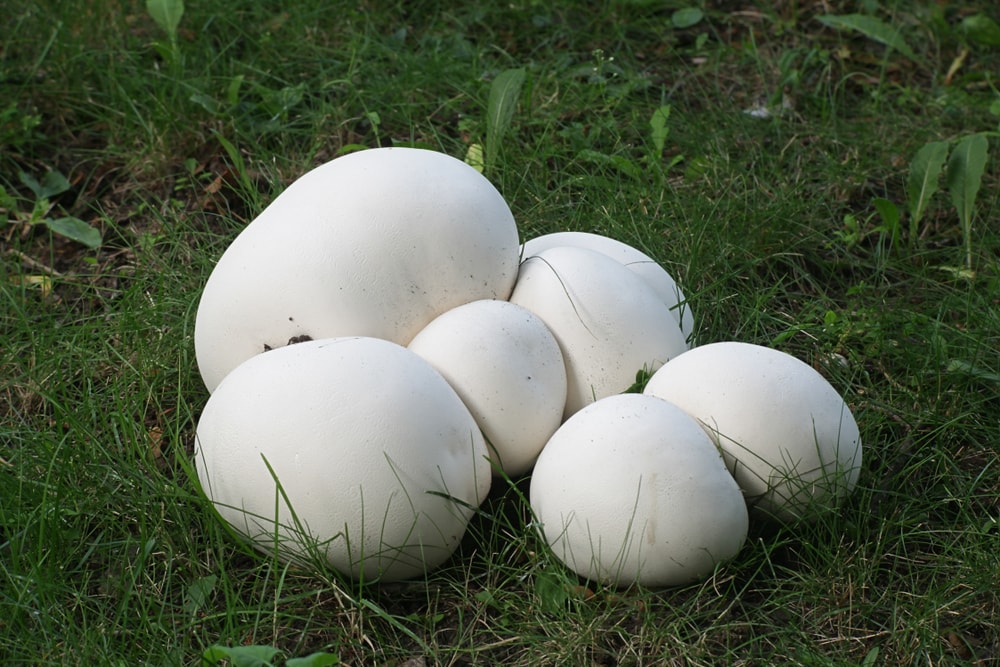
Giant Puffball is a huge mushroom that grows in grassy fields. It’s solid through to the core when young with firm white flesh.
The giant puffball can release 7 trillion spores from one specimen, which is the most progeny out of all living things! If all the spores from two giant puffballs grew into adult mushrooms, they’d have a cubic area 800 times the volume of the Earth!
Make sure you pick it at this stage, however, as it eventually goes soft and black in the middle. It’d be too late to eat it then. Additionally, one giant puffball is all you need for a meal to feed your whole family.
I once ate this delicious mushroom fried in thick slices with bacon. I’ve also eaten it baked in a clean pedal bin over a fire, stuffed with gruyere cheese and herby couscous.
11. Sweetbread Mushroom – Clitopilus prunulus
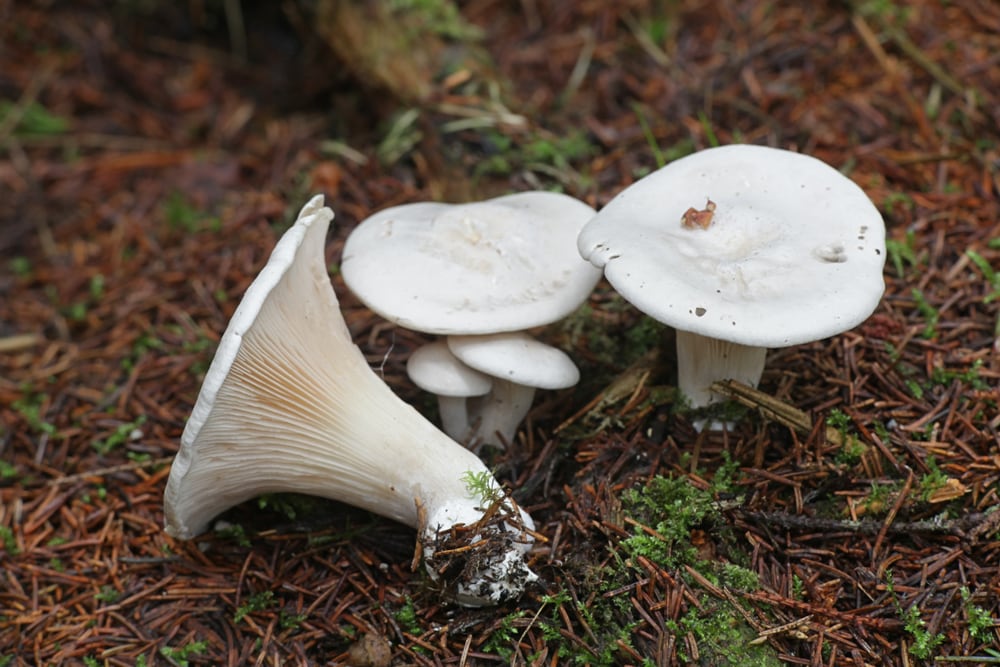
Also called the Miller, this mushroom is gray or white and firm with solid flesh. The cap is slightly wavy and the gills run down the stem. This mushroom can be confused with the Ivory Funnel (Clitocybe dealbata), which is poisonous.
It’s called the Miller due to its smell, which reminds people of an old grain mill. The scientific term for this smell is farinaceous, which means it smells like raw pastry.
The sweetbread mushroom has weird spores shaped like a ridged American football. You will need a microscope to see these properly, though.
Here’s a recipe for wild sweetbread mushroom quiche!
12. Brown Wood Mushroom – Agaricus sylvaticus
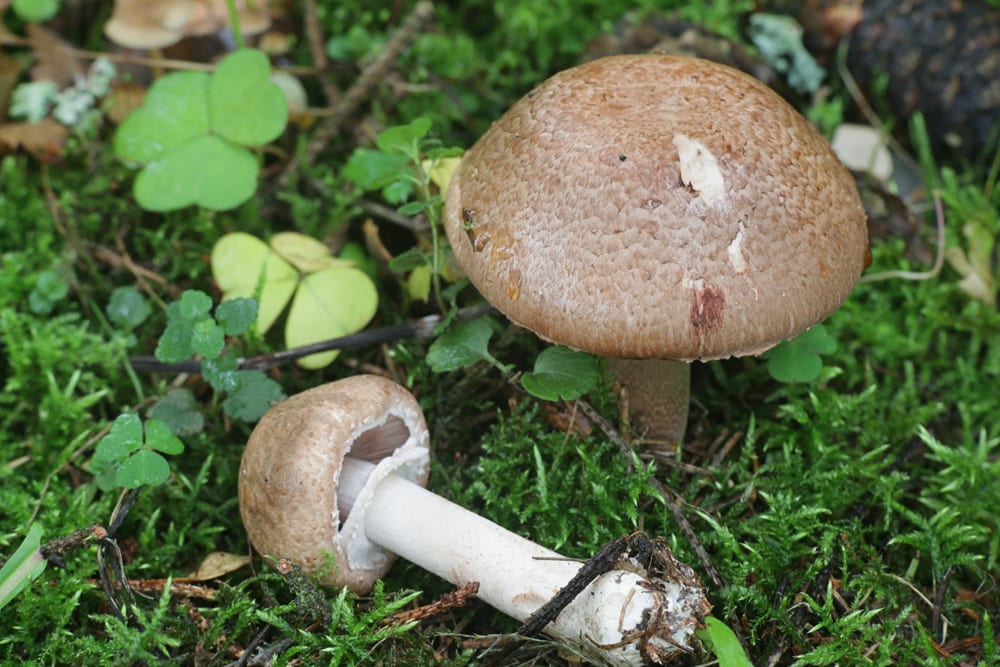
Normally, brown wood mushrooms are found in woodlands and at the edges of paths. You can find it in the UK, Europe and North America. I also find these growing in the caretaker’s garden of my son’s school.
It has a light brown dry cap and a big loose skirt on the stem. When it matures, the gills turn from light pink white to dark brown. This is one of the Agaricus mushrooms, a family that contains several nice edibles.
It’s also known as the Blushing Wood mushroom as it stains pinkish-red when cut. But don’t worry, this is totally harmless.
13. Field Mushroom – Agaricus campestris
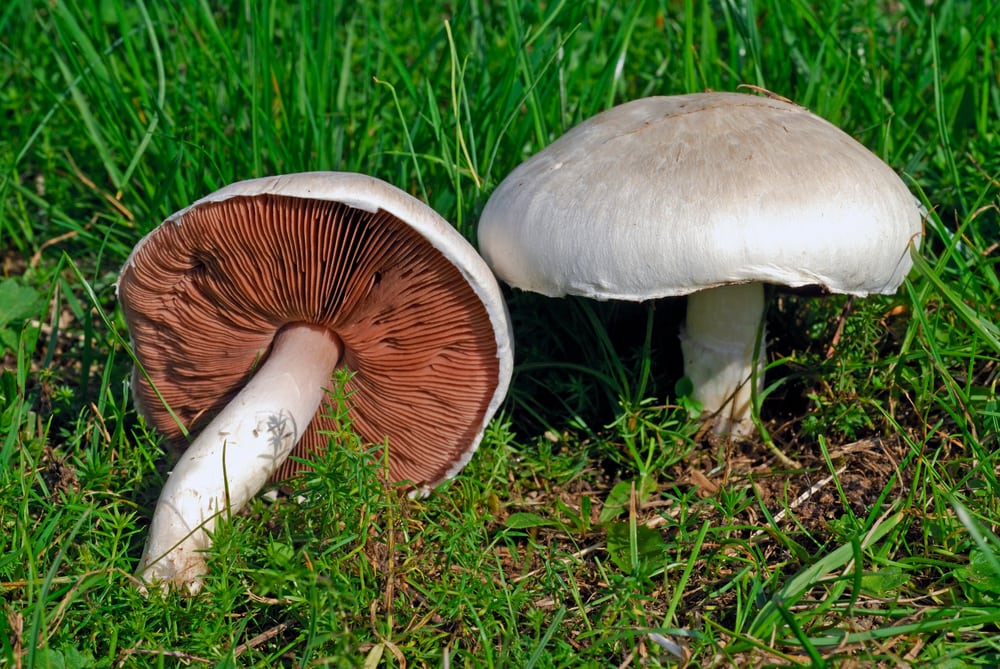
This well-known edible is found in meadows in Europe, North America, and the UK.
It has a creamy white, dry cap and a short thick stem with a loose skirt on it. The light pink gills eventually turn brown as it grows older.
This mushroom can be confused with the vomit-inducing yellow staining Mushroom (Agaricus xanthodermis), which looks virtually the same. To identify which is which, cut the mushroom and wait 15 minutes to see if it turns yellow. If it does, it’s a yellow staining mushroom.
I’ve eaten these raw when hiking. As long as you properly rinse them, field mushrooms are safe to eat raw. You can also cook it with garlic and butter or add them to omelets.
14. Shaggy Inkcap – Coprinus comatus
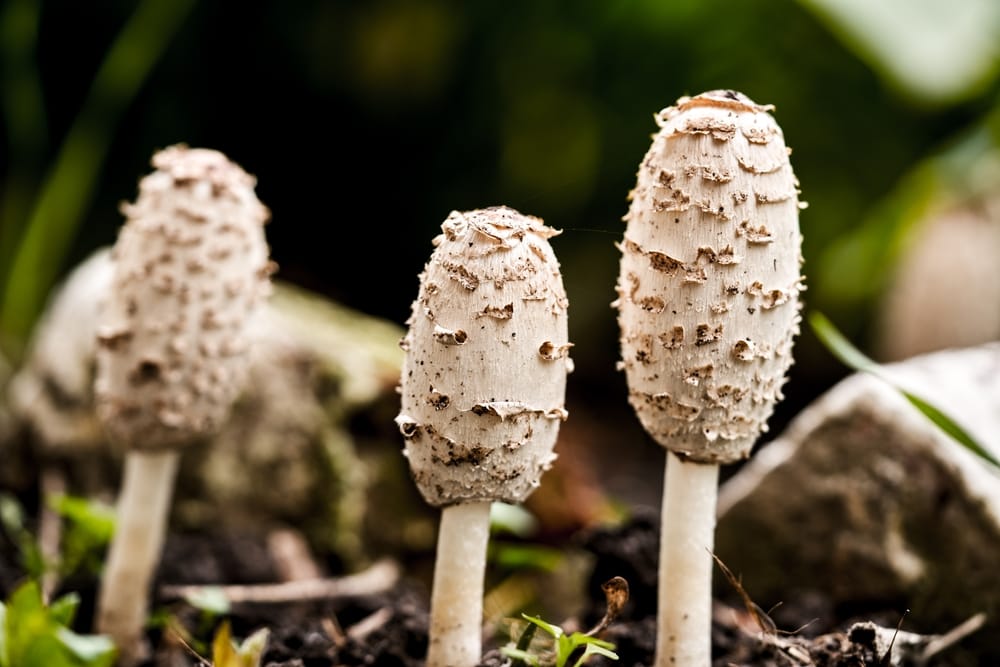
This distinctive fungi’s other name is Lawyer’s Wig, and you can see why!
It has a long white cap with shaggy rings down it. When young and tightly closed, these mushrooms are a great wild edible. They are called “drumsticks” at this stage.
As Shaggy Inkcaps get older their caps spread into a bell. Their gills go black and begin to deliquesce. This means they leak black fluid and start to break down.
In older times, people used this black mushroom liquid as ink for quill pens. Check out how to make edible mushroom ink here or Parmesan Crusted Shaggy Manes here.
You can find them in Scandinavia, the Mediterranean, the UK, Europe, the Iberian Peninsula, and North America.
15. Charcoal Burner – Russula cyanoxantha
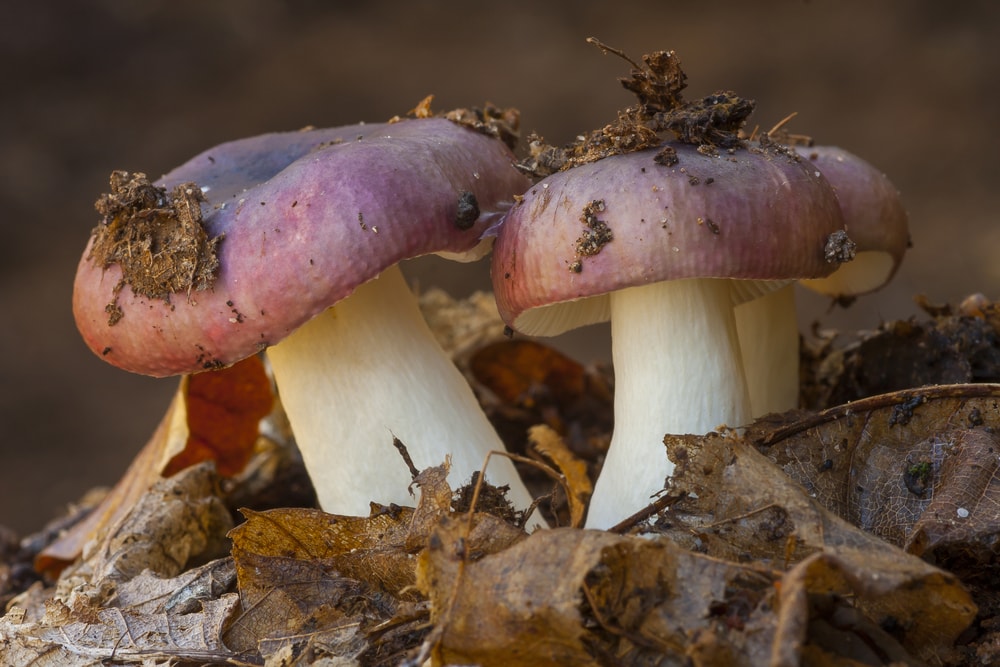
The Charcoal Burner belongs to the family Russulaceae or “Brittlegills”.
Russulas have a chalky, fragile texture and crumble easily. This brittleness is due to the number of rounded hyphal cells – called sphaerocysts – in the Russula’s flesh.
The Charcoal Burner isn’t as brittle as others in this family, though.
Its cap can be many colors ranging from green to brown to gray to pink! The thick stem leads to crowded, greasy white gills.
You can eat Charcoal Burners as a fried dish or add it to omelets or mushroom stew. They’re known to have a nutty taste.
16. Meadow Wax Cap – Cuphophyllus pratensis
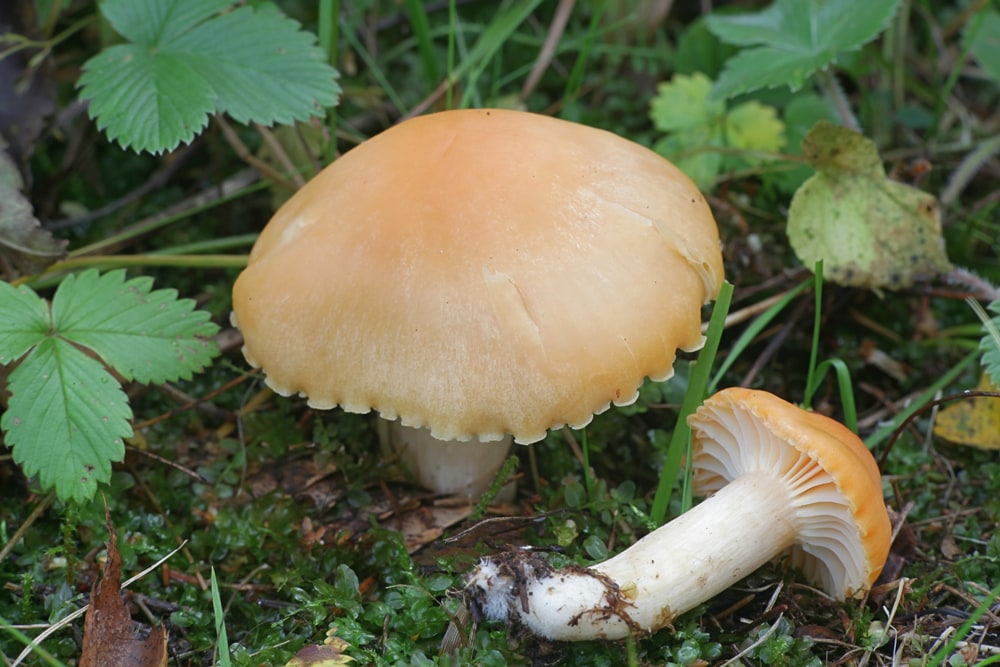
The Meadow Wax Cap has a wide distribution. It’s found in temperate meadows in Europe, North Africa, North and South America, Northern Asia, Australia, and New Zealand.
It’s sometimes sold in commercial markets. It’s known as the “Butter Meadow Cap” and “Salmon Waxy Cap.”
If you touch the cap or gills, they feel waxy, which gave it its name. The gills are widely spaced and have smaller gills in between the large ones.
There’s some really beautiful mushrooms in the wax cap family. The parrot waxcap and its fluorescent colors is one example. You can also learn more about the Wax Cap mushroom family here!
17. St. George’s Mushroom – Calocybe gambosa
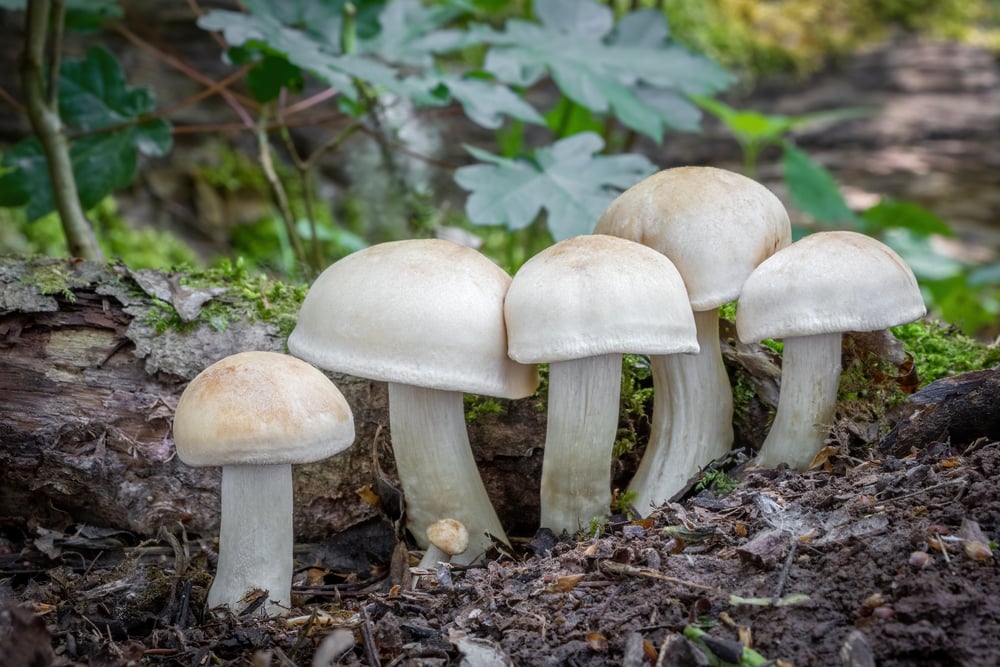
St George’s Mushroom is famous for growing in the Spring. It usually appears around St George’s Day in England, which is the 23rd of April. Its season is short, only lasting till May. It is known as Marzolino in Italy and Maipilz in Germany.
It has a thick white stem with no skirt, and a gray white cap. The gills are white and crowded. It grows in rings in grassland, often near hawthorn trees.
This mushroom is nice with a cream sauce but don’t eat it raw!
Its poisonous lookalike is the Deadly Fibrecap, which stains red when cut and is covered in fibrous hairs.
18. Puffballs – Lycoperdum
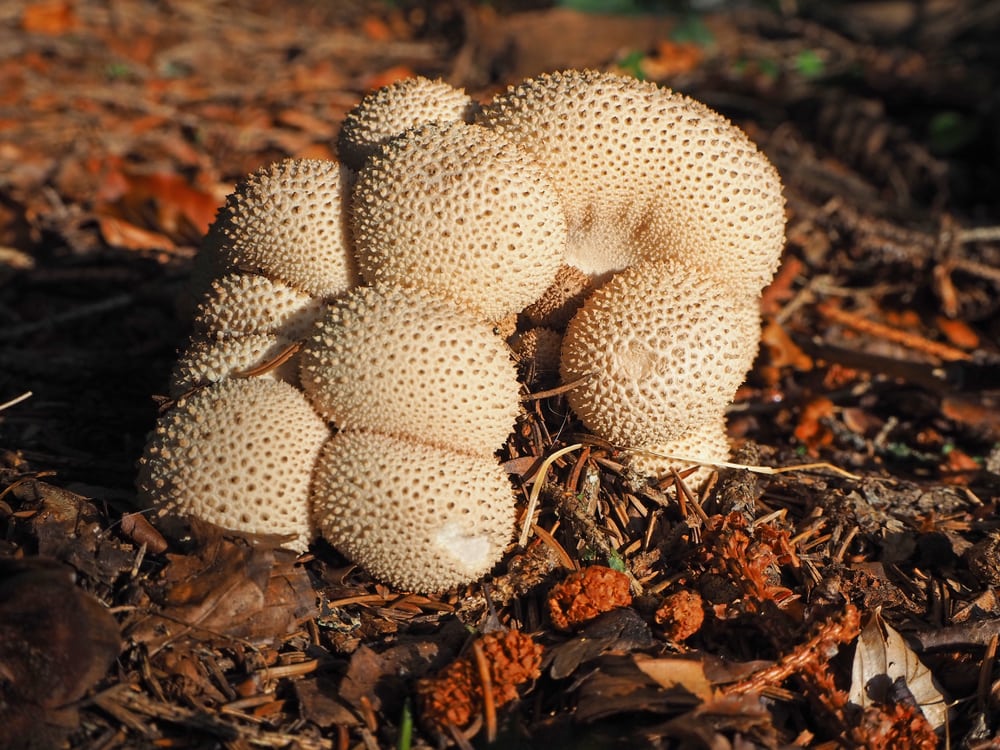
Common puffballs are found in grasslands. L. pyriforme puffballs are found on rotting stumps of wood at woodland edges.
Puffballs can be colored creamy white to tan depending on the species. They have no visible stem, which makes them look a lot like pebbles. They have a crumbly coating on top of the cap.
Toxic Earth Balls look similar, but they have a yellow-brown color and a cracked leather texture.
When pushed or agitated, puffballs puff out their spores at the top. Puffball spores can cause lung disease, however, so try not to breathe in the spores.
All puffballs are edible when young and firm. When they get older, they turn black inside and soft on the outside.
Puffballs have a “roasted” smell. If you’d like to try them as a dish, I love to fry them and put them on top of creamy pasta.
19. Golden Coral – Ramaria aurea
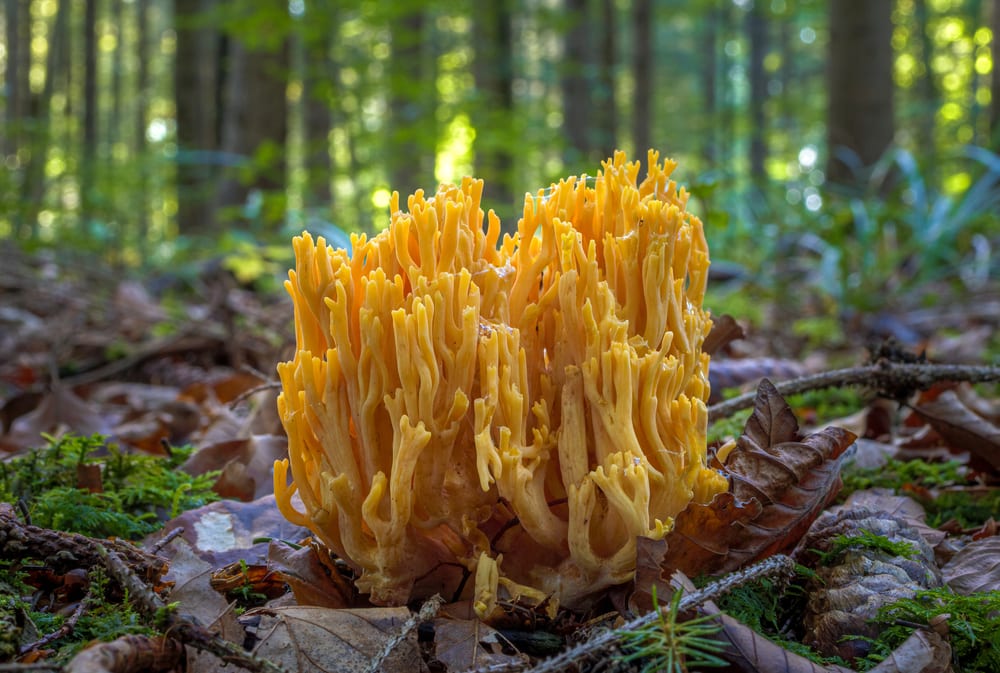
This stunning golden coral is a bright orange to yellow, giving it its scientific name, aurea, which means “gold”. This mushroom has brittle coral-like projections, too. You can find gold corals in Europe and North America.
It can be easily confused with other inedible or poisonous coral fungus species such as Yellow-Tipped Coral Fungus (Ramaria formosa) and Jelly Antler (Calocera viscosa).
It needs to be well-cooked. It contains a lot of oxalic acid, which is the same chemical you find in rhubarb. Try baking it with eggs or cook it like broccoli!
20. Hedgehog Mushroom – Hydum repandum
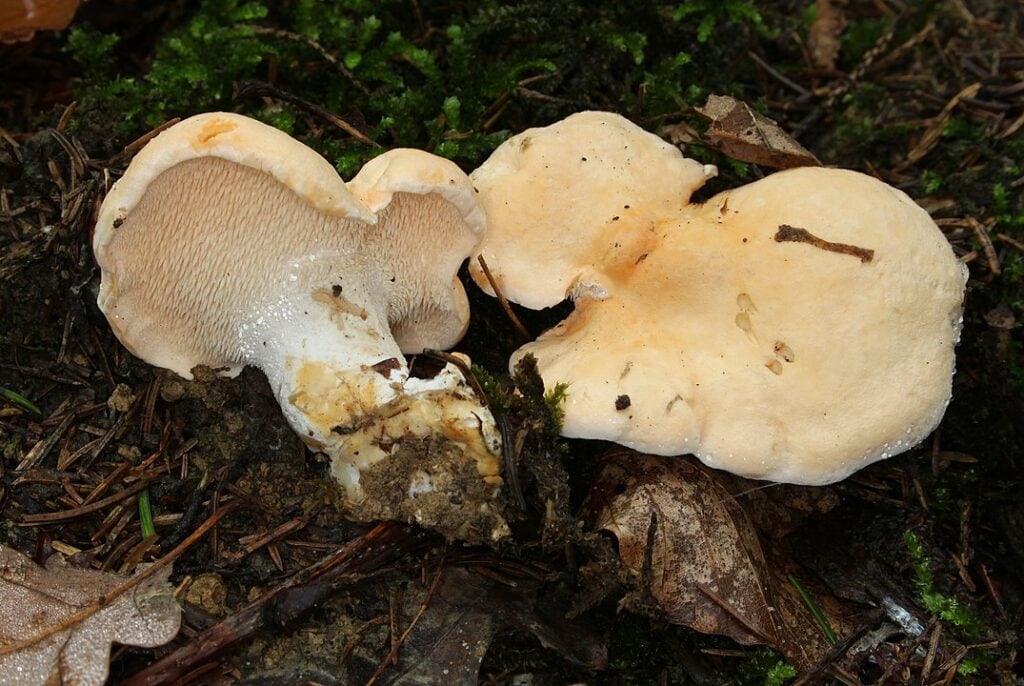
Unlike the previous mushrooms, the aptly-named hedgehog mushroom has spines instead of gills. Underneath the cap are short spikes like a hedgehog’s spines.
To find this, look beneath beech or western hemlock trees for a mushroom resembling a puddle of spilled cream.
There are several subspecies, such as the Western Bellybutton Hedgehog (Hydnum oregonense) and the Terracotta Hedgehog (Hydnum rufescens). Fortunately, hedgehog mushrooms don’t have any poisonous lookalikes.
These mushrooms have a smoky, buttery, and fruity taste. They’re best eaten sauteed or boiled. Try them in a pot pie or with butter and parsley. There’s some recipes here.
21. Cauliflower Fungus – Sparassis spathulata
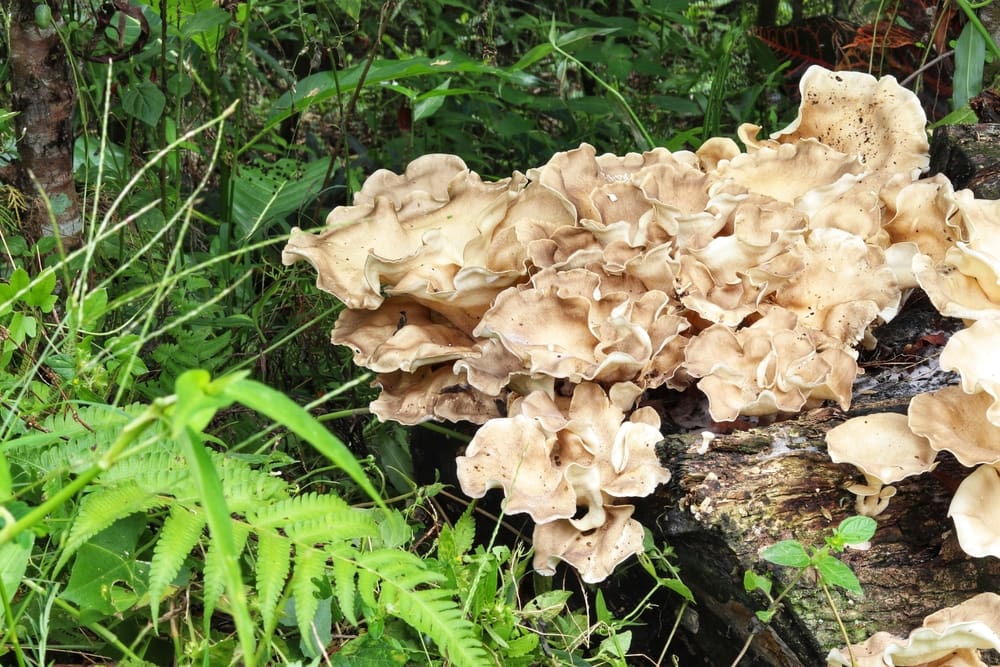
This fungus looks just like a coral or a cauliflower. It even has the same creamy white flesh with pores underneath instead of gills.
You can find it growing at the base of conifer trees. One was found weighing 30 kg (66 lb) in the south of France.
It can be tricky to clean, as dirt and bugs like to hide out in it. Despite that, it’s very tasty and has a texture like chicken.
22. Wood Ear – Hirneola auriculae-judae
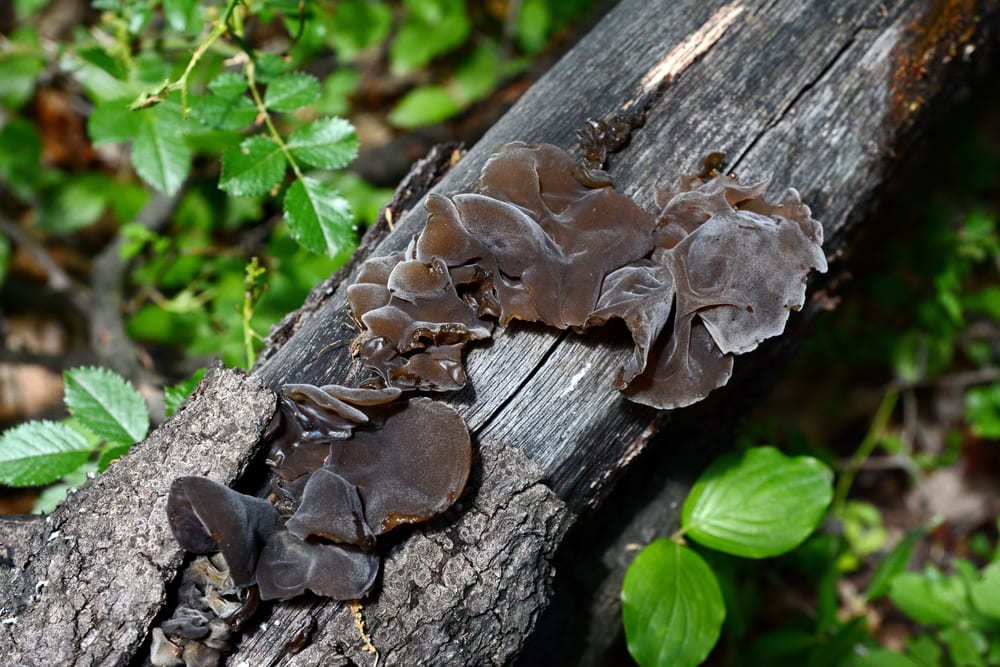
The Wood Ear, also known as the Jelly Ear or Jew’s Ear, has a close relationship with elder trees. It grows on old elder branches and stumps.
It has a soft and gelatinous texture – like jelly! It’s a reddish-brown color and looks a bit like an ear.
Wood ear can be fried, although this makes it lose water and shrink into mush. The best thing to do with it is to simmer it in miso or other clear soup. It doesn’t have much taste, but it does look nice.
Forager Fergus Drennan pulls wood ear fungus apart and stuffs them with soft cheese and herbs, then boils them like dumplings. You can check it out here:
23. Orange Peel Fungus – Aleuria aurantia
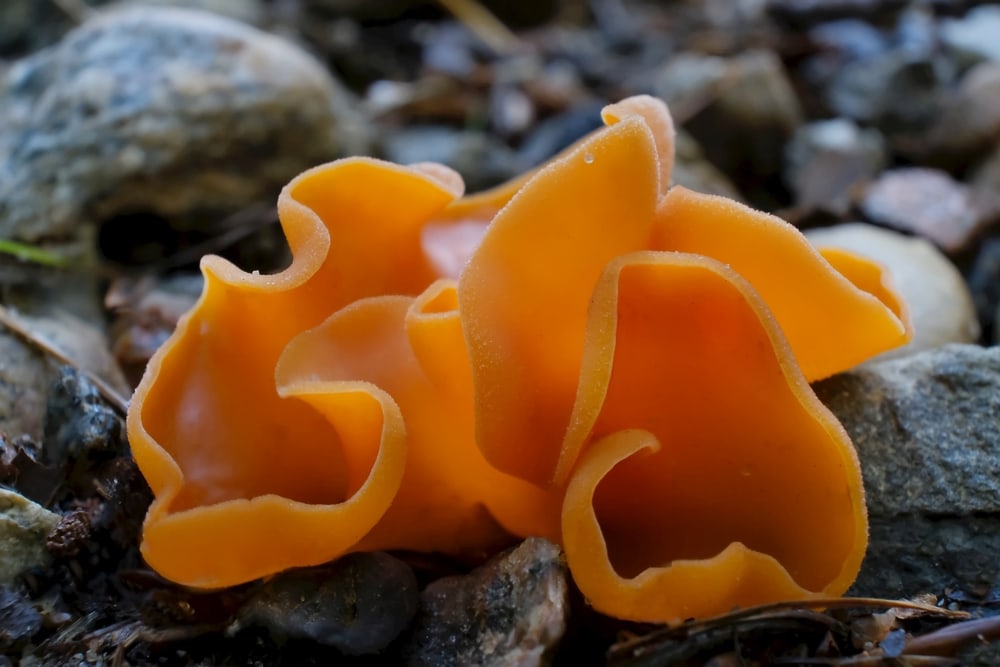
This bright orange fungus looks just like a discarded orange peel. It likes wood chips and gravelly soil – basically anywhere that’s been disturbed.
Though it’s edible, It doesn’t taste like much and won’t fill you up. But it does look great in a garden party salad or a cocktail as a garnish!
Try not to confuse it with its poisonous lookalike, the Scarlet Elf Cup. This species has a darker-colored depression in its cup-like cap.
24. Black Truffle – Tuber melanosporum
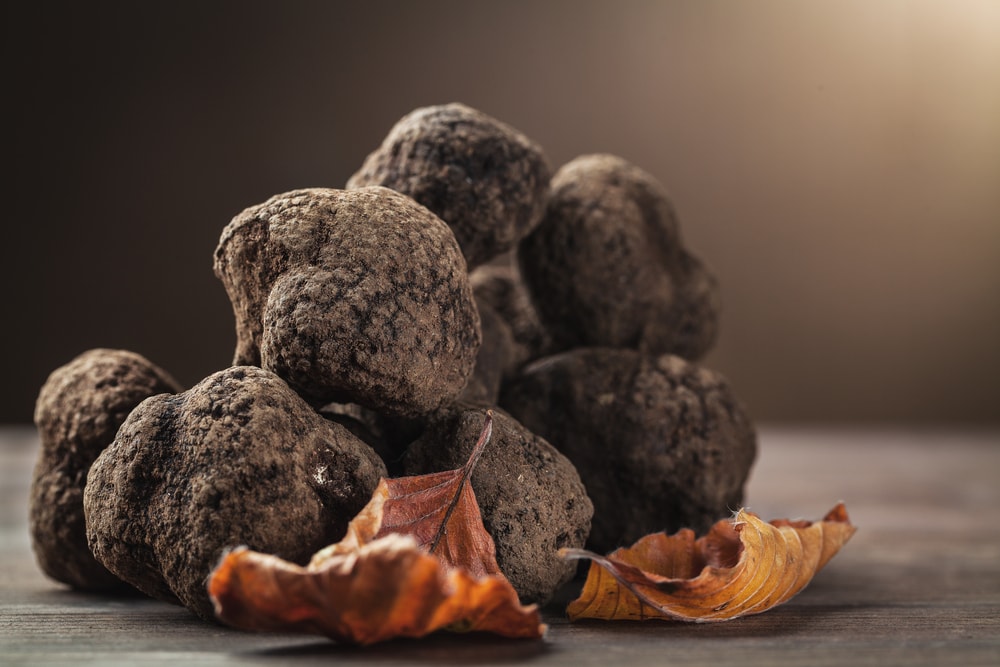
This famous edible is one of the most expensive mushrooms in the world. The average price per kilo can range from $82.08 to $3386.24. The Perigord region of France is well known for its black truffles.
Truffles grow in symbiosis with oak roots. They spread their spores by smelling like the sex hormone of a male pig. This encourages pigs to dig them up and eat them. Then, the pigs excrete the truffle’s spores out in a new habitat, allowing new truffles to grow.
It is traditionally harvested by pigs or dogs as it grows and fruits under the ground.
Truffles are used to flavor oil. They can be grated onto potato or egg dishes and they go well in a wine or cream sauce. If you really want to show off, lay them on roasted game meats!
25. Lobster Fungus – Hypomyces lactifluorum
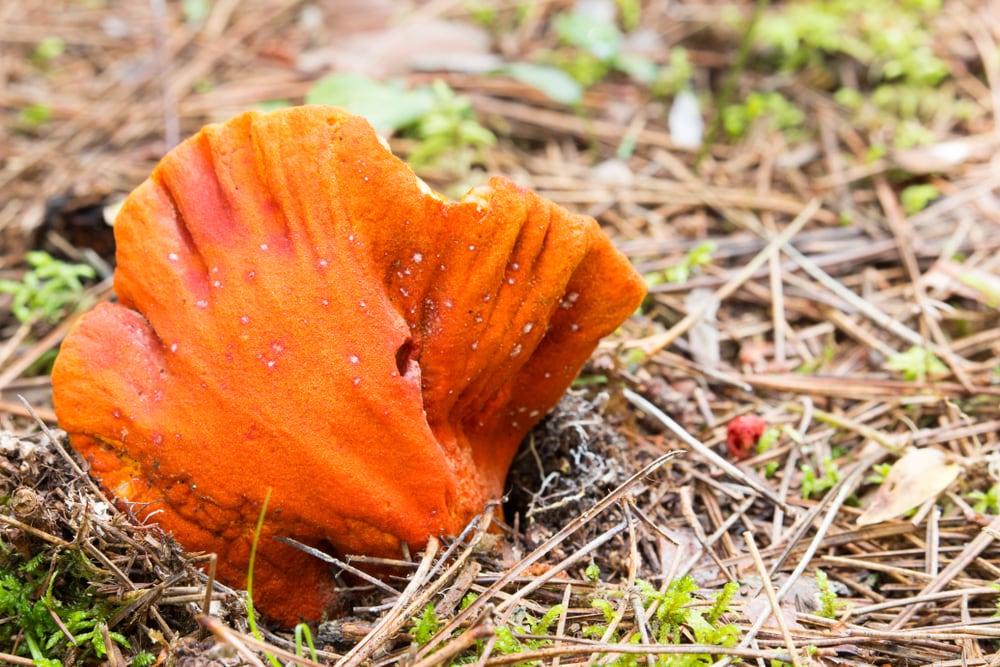
This fungus is a combination of a host mushroom and a parasitic fungus living on it. This causes the host mushroom to curl into itself, become bright orange, and taste like seafood!
It makes the host body of the Russula or Lactarius mushroom become hard and pimply. This is what gives it the appearance of a lobster shell.
They’re often sold in Mexican farmer markets where they’re called Tromba de Puerco or pork horn.
The usual preparation method involves boiling them first, followed by frying with onions and tomatoes, and serving with tortillas. It’s commonly used as a meat alternative in cooking.
26. Common Ink Cap – Coprinopsis atramentaria
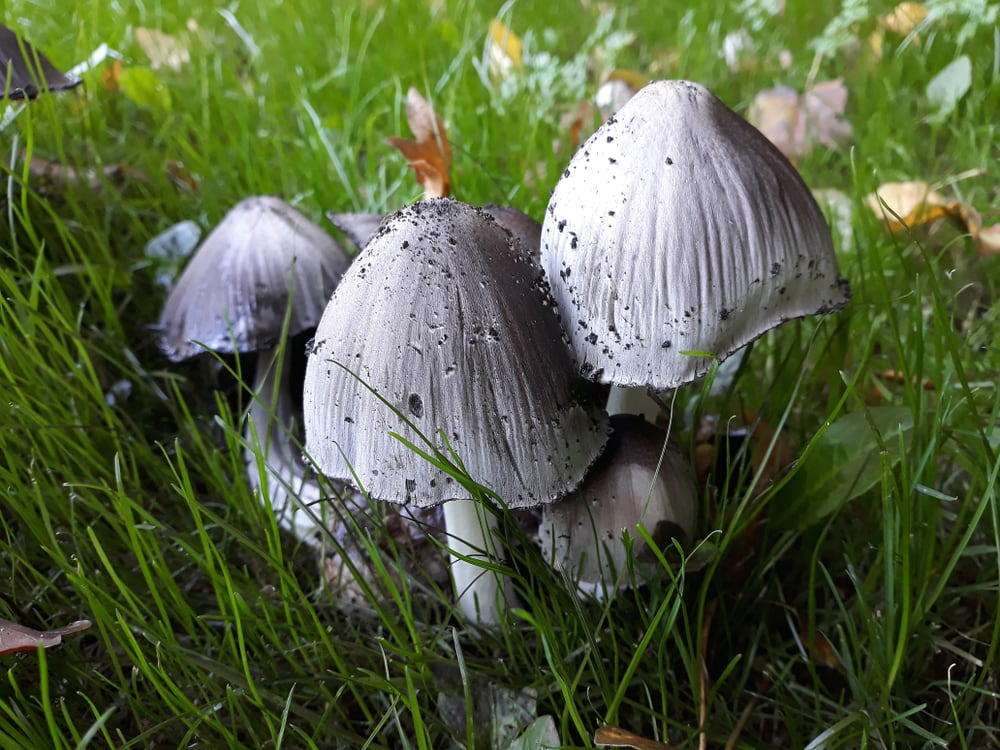
A close relative of the Shaggy Ink Cap, the Common Ink Cap also deliquesces into black ink.
It is edible but becomes severely poisonous when combined with alcohol. This feature has been used in a drug to prevent alcoholics from relapsing! Drugs such as Antabuse and disulfiram contain coprine, which is found in these mushrooms.
To eat ink caps, you can either consume it raw or fry it. Alternatively, you can also brew it in tea.
27. Cremini Mushroom – Agaricus bisporus
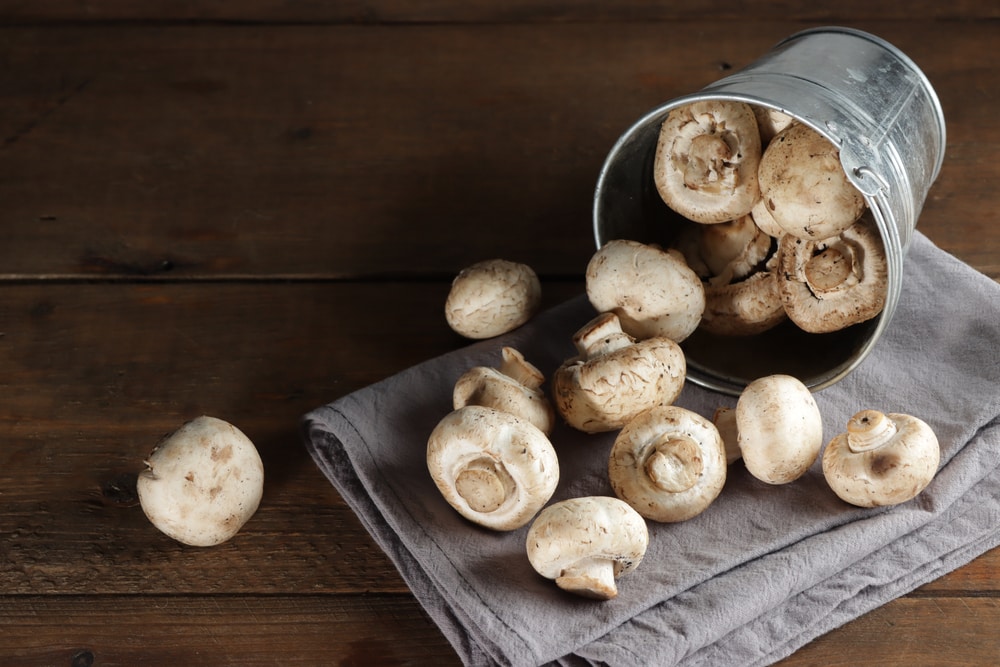
Also called “Baby Bellas,” these friendly Agarics are a more mature version of the button mushrooms you buy in the supermarket. The only difference is that they have a stronger flavor.
The cap is very closed and you can’t see the gills. Cremini mushrooms have a rich brown tan color. They also look more like a wood mushroom when they’re allowed to mature – with brown gills and a scaly spread cap.
Cremini mushrooms taste great with scrambled eggs, or added in a salad. They have a crisp, firm texture.
29. Dryad’s Saddle – Cerioporus squamosus
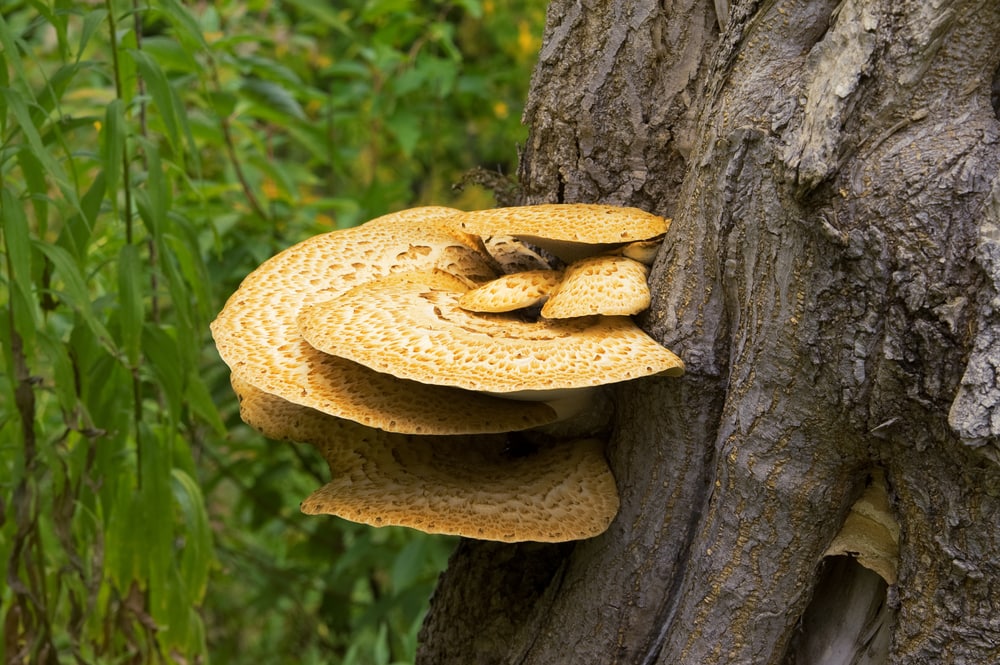
This common bracket fungus grows out of dead and living hardwood tree stumps. It has a scaly upper surface with a concentric ring pattern. This looks a bit like the back of a pheasant, so another name for this mushroom is Pheasant’s Back.
In Greek mythology, dryads are nature spirits living in trees who often take on the form of young women. They were reputed to ride this mushroom, hence the name.
These mushrooms can be tough to eat, so it’s best to pick younger specimens for consumption. I cooked this over a campfire in a stew and made my mouth feel rather dry!
29. Gray Oyster Mushroom – Pleurotus ostreatus

All varieties of the tender oyster mushroom are edible. They grow like bracket fungus but have a short stalk. The cap can vary in color from dove gray to golden depending on subspecies.
Oyster mushrooms are carnivorous. They trap nematode worms in their tissues and feed on them to get hold of nitrogen. They can also be used to clean up oil spills as they can digest hydrocarbons!
Oyster mushrooms are a popular edible mushroom and widely cultivated. You can buy spores embedded in dowel pegs to insert into trees if you want to grow your own.
30. Red Pine Mushroom – Lactarius deliciosus
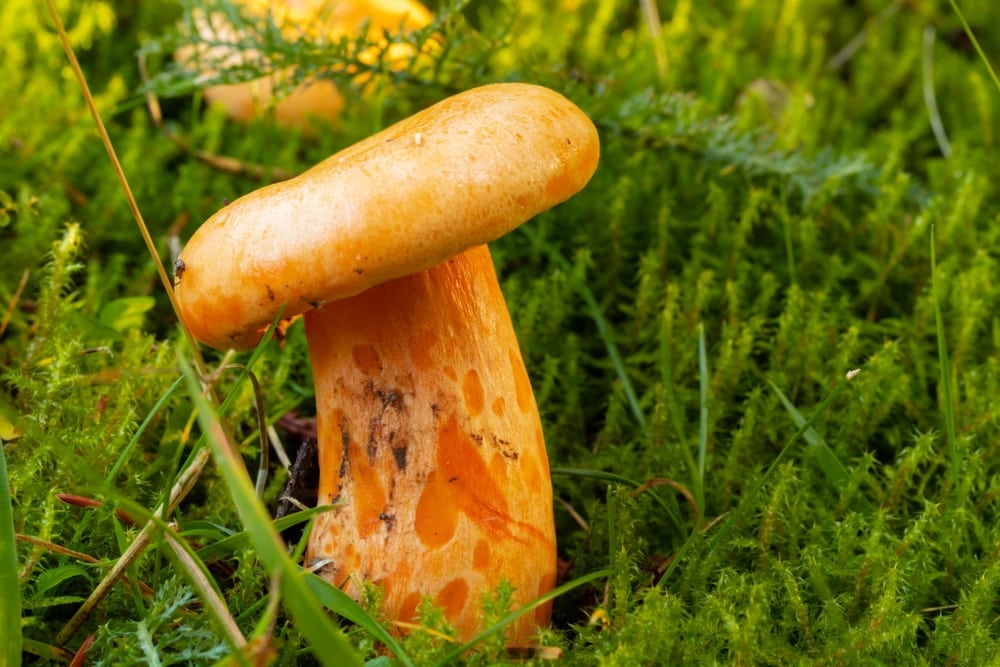
Also known as the Saffron Milkcap, this fungi has a wide range from Romania to Spain to Turkey and North America. It can even be found in Australia! It has orange gills when mature and an in-rolled margin on the cap.
It’s in the milk cap family, so it leaks a milky fluid when cut. It is traditionally boiled in salty water to remove the bitter flavor caused by the milky sap.
You can grill strips of it with meat and onions or shred it to be stir fried.
31. Eryngii or King Oyster Mushroom – Pleurotus Eryngii
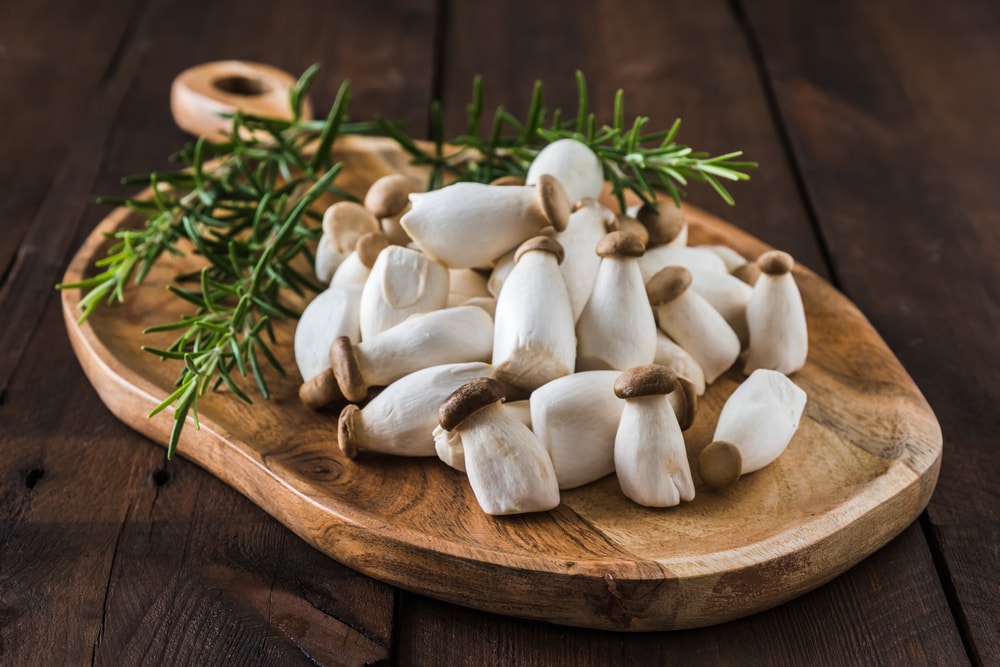
The King Oyster mushroom is part of the Pleurotis oyster family, but it doesn’t branch out of trees on a short stem. Instead, it grows sturdy and upright.
This mushroom is grown commercially. If they are grown without light and kept sheltered indoors, they produce a mushroom with a huge white stem and a tiny cap. If outdoors, it grows a tiny stem and a large and dark cap.
It grows on the roots of hardwood trees from Southern Europe, Russia, North Africa and Asia.
You can cook this mushroom a variety of ways, be it sautéed, roasted, grilled, or even stir-fried.
32. Nameko Mushroom – Pholiota nameko
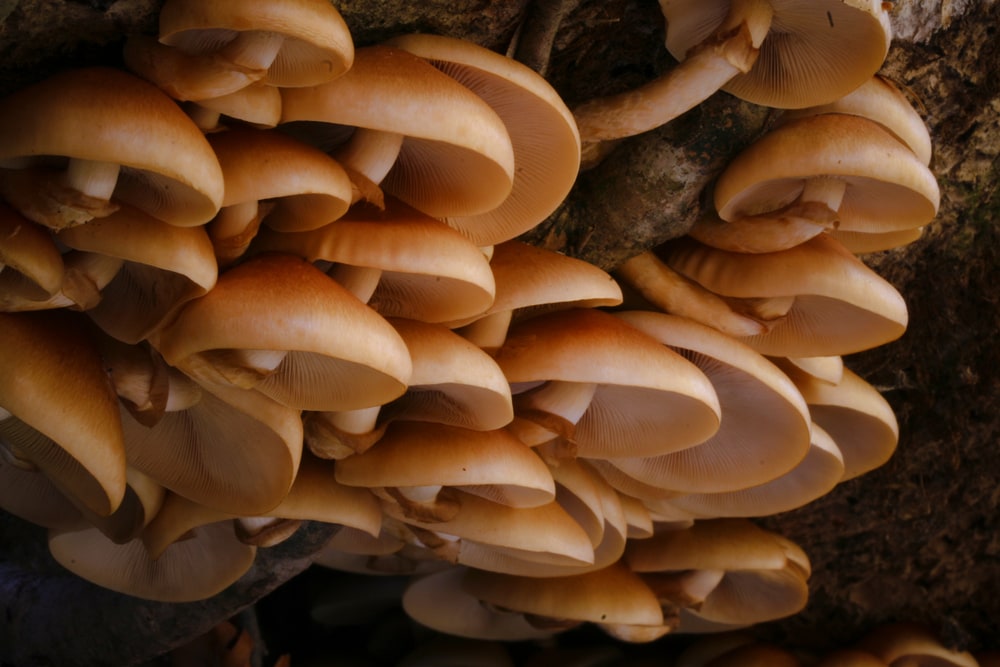
Nameko mushrooms have a natural gel on their caps that acts like gelatin in soups, stews, and tapas. They are the most popular cultivated mushroom in Japan. It goes well in miso soup and with game meats.
It grows on fruit trees and other hardwoods and fruits once the temperature drops below 50℉.
Learn how to grow Nameko mushrooms below!
34. Podberezoviki/Brown Birch Bolete – Leccinum scabrum
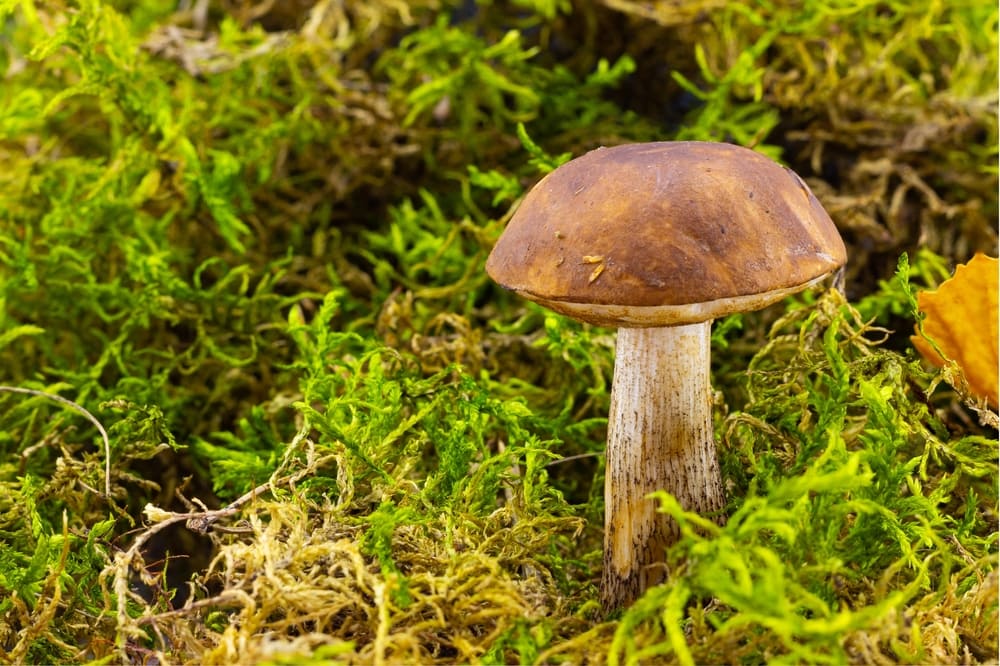
The brown birch bolete bears a cap that ranges in color from reddish-brown to dark brown. The cap is convex when young and then flattens out with age. The stem is typically thick and bulbous with a scaly texture
It’s popular in Eastern Europe and Russia, and grows in North America and the Iberian Peninsula. It usually favors birch trees in Britain and Ireland.
This isn’t in the league of a Bolete like the Cep, but it’s edible. It makes a nice addition to a mixed mushroom stew or soup. Occasionally, some people get digestive issues with the Leccineum species.
35. Deceiver – Laccaria laccata
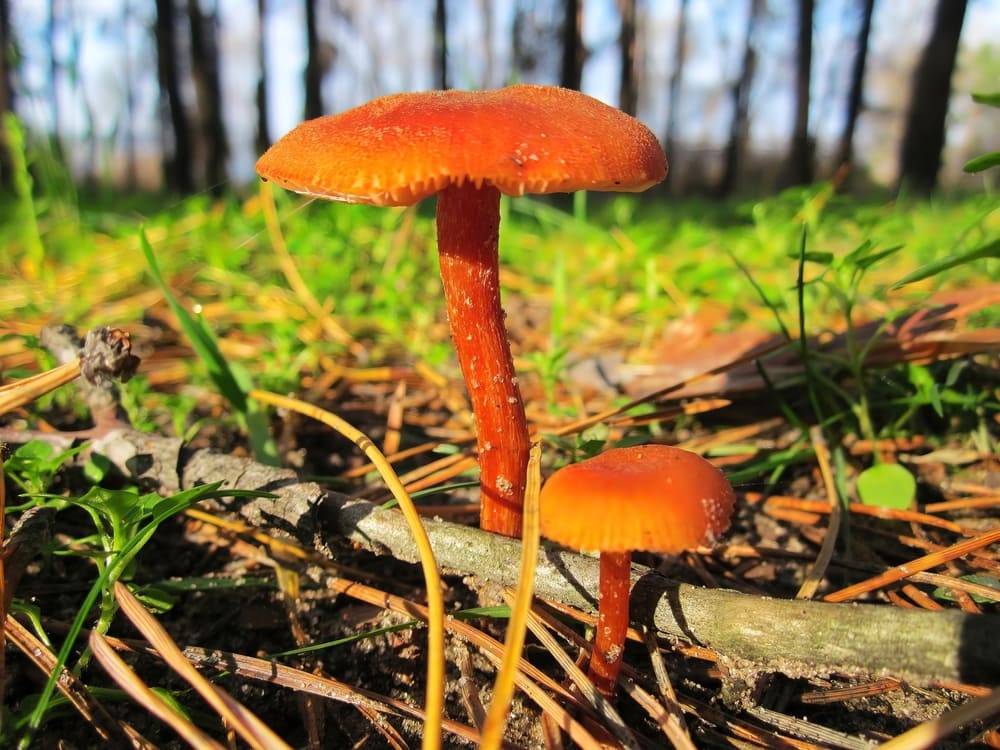
A close cousin of Amethyst Deceiver, this little fungus is also edible. The Deceiver is not quite as tasty as the Amethyst Deceiver, however.
It’s tan-colored and looks like many other small fungi, which is why it’s called the Deceiver! It has no definite cap shape or color.
The gills are widely spaced and the flesh is tough, so throw away the stem and use only the cap.
Deceiver mushroom caps taste pretty good when fried and can also be a lovely ingredient for mushroom soup.
35. Aniseed Funnel Mushroom – Clitocybe odorata
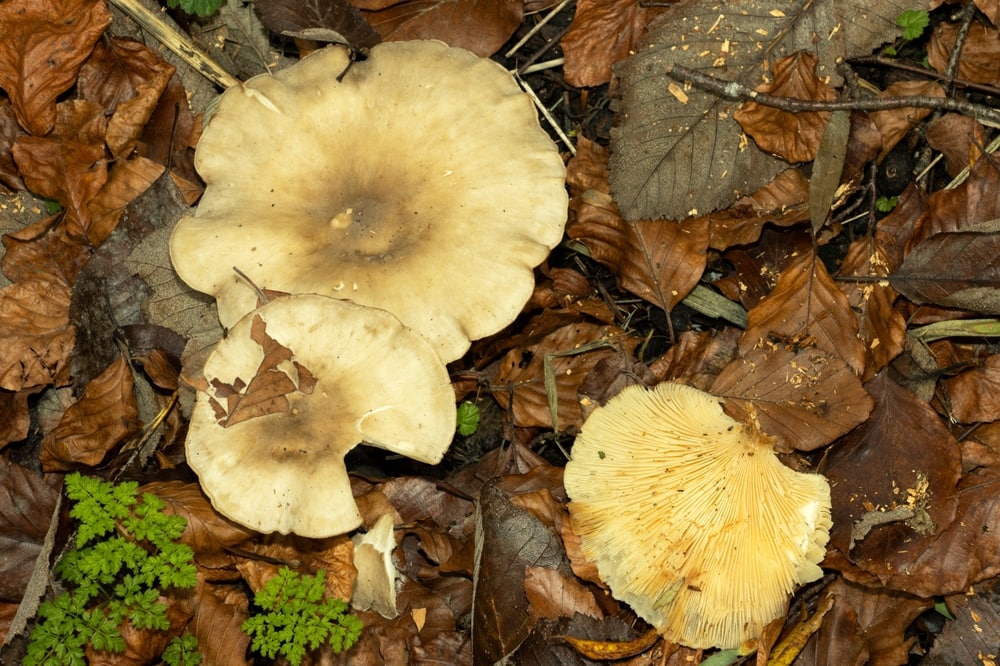
This funnel-shaped mushroom starts off a lovely light blue color, then fades to gray. You can smell it before seeing it, as it gives off the strong smell of aniseed!
You can use it to flavor sauce for fish or add it to a risotto. It can be overpowering in large quantities, so you’d only need a small amount to flavor food. It can also be powdered and used as a condiment.
36. The Blusher – Amanita rubescens
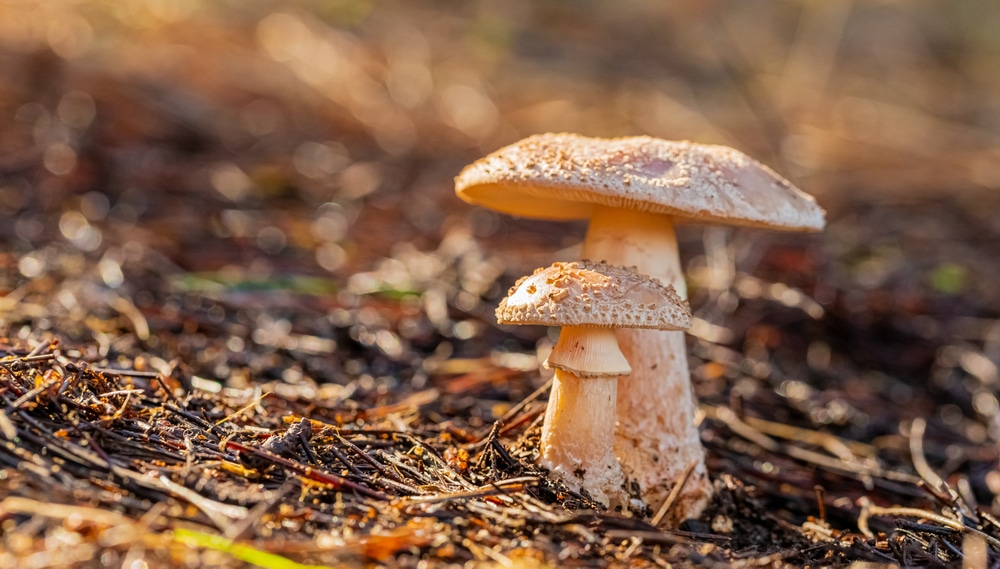
The Blusher looks very similar to the very poisonous Panther Cap. They’re also in the same family – the Amanitas.
Blushers have a ring on the tall stem and scales on the cap. You need to look hard to tell them apart.
If you cut a blusher lengthwise, it will start to blush pink or red. It has a skirt on the stem and grows out of a volva or sac at the base. This volva disappears when older, leaving just a bulbous base.
They are soft and easily damaged in transit. The flavor is not that amazing, however. Just make sure to cook it before eating, as it cannot be eaten raw. It’s said to have a beef-like flavor once cooked.
37. Glutinous Gomphidius – Gomphidius glutinosus
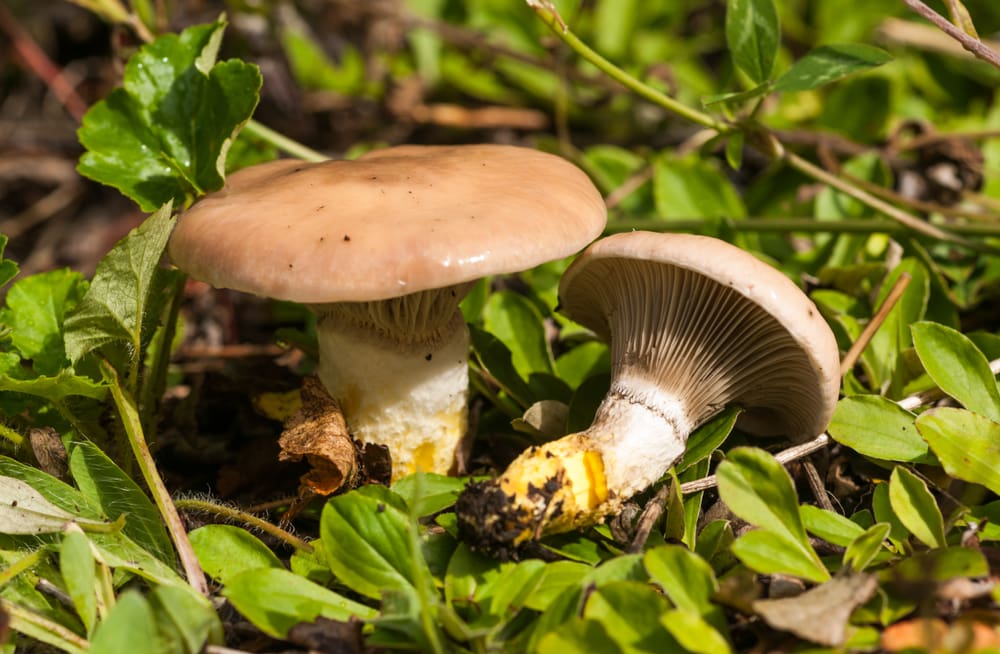
It has a slimy, olive-brown cap and a thick stem with a yellow-brown color. The gills on the underside of the cap are widely spaced and are initially white but become gray-brown as the mushroom matures.
This Boletus family mushroom is particularly slimy when it gets wet! Its other name is the Slimy Spike Mushroom. It’s common in Northern Scotland and Scandinavia and can be found in Britain and Ireland where it’s not as common.
This mushroom is quite rare, so care should be taken in gathering this species for the pot. It can be used in soups and stews, where its slimy texture can add a unique element to the dish.
38. Bohemian Verpa – Verpa bohemica
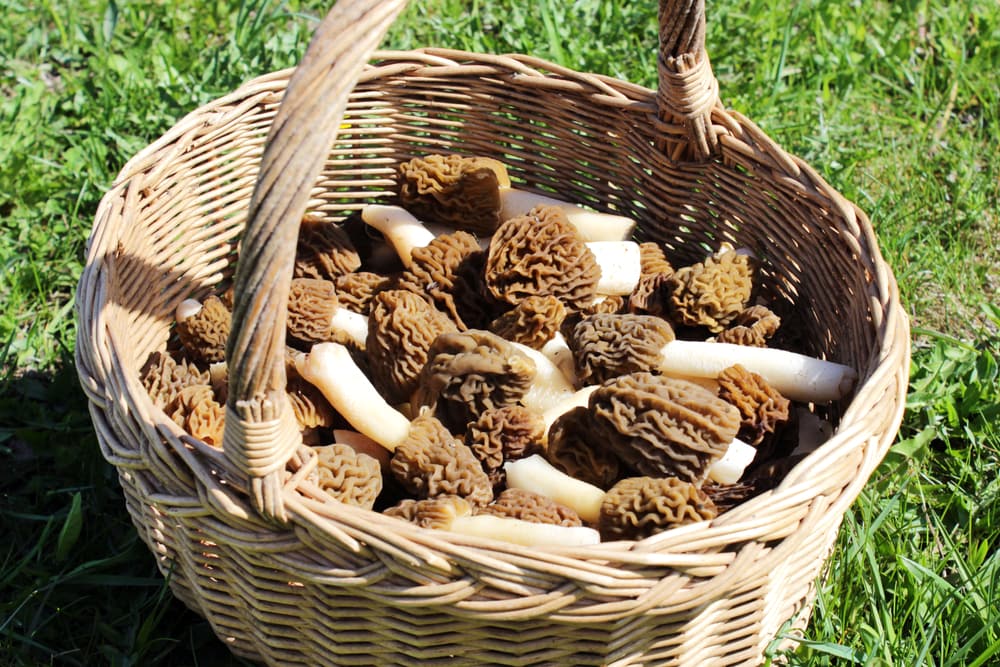
The Bohemian Verpa has a tall, hollow stem with a bell-shaped cap that is pale yellow to brown in color, with a wrinkled or ridged texture.
It grows in the same locations as the morel. Since these two look similar, it causes a lot of confusion. But they’re both edible, so this isn’t too worrying! The Verpa has an inferior taste to the true Morel, however.
To tell the difference, check how the cap attaches to the stem. In the Verpa, the cap is only attached to the center of the stalk. Inside the stem it has wisps like cotton candy.
You can use this mushroom as a substitute for morels in a shallot vermouth sauce, which you can find the recipe for here.
39. Velvet Shank – Flammulina velutipes
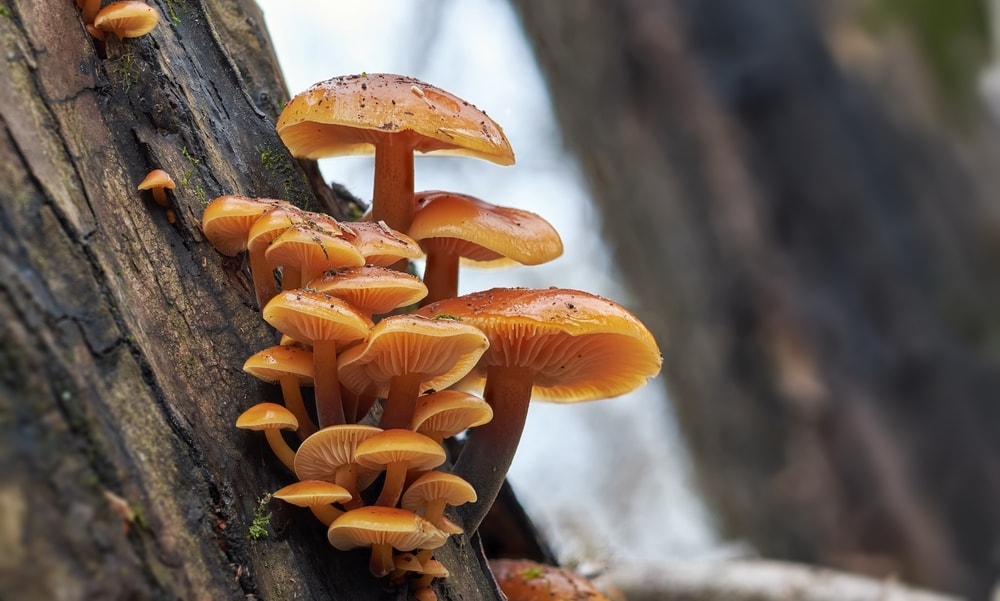
The Velvet Shank mushroom has an orangish to reddish or yellowish-brown cap with a sticky, almost rubbery texture. The stem is velvety and darkens from the base upward.
This mushroom is a handy find in cold months, as it can survive being frozen solid. This means it’s still around to eat when there’s not much else. You can typically find it in damp woodlands.
Check the stem to make sure it doesn’t have a skirt. If it does, it’s likely to be Galerina marginata, which is its poisonous lookalike. The Velvet Shank has a velvety stem which is dark-colored.
Remove the skin on the cap before consumption. The young buttons are tasty when dried.
40. Sooty Head – Tricholoma portentosum
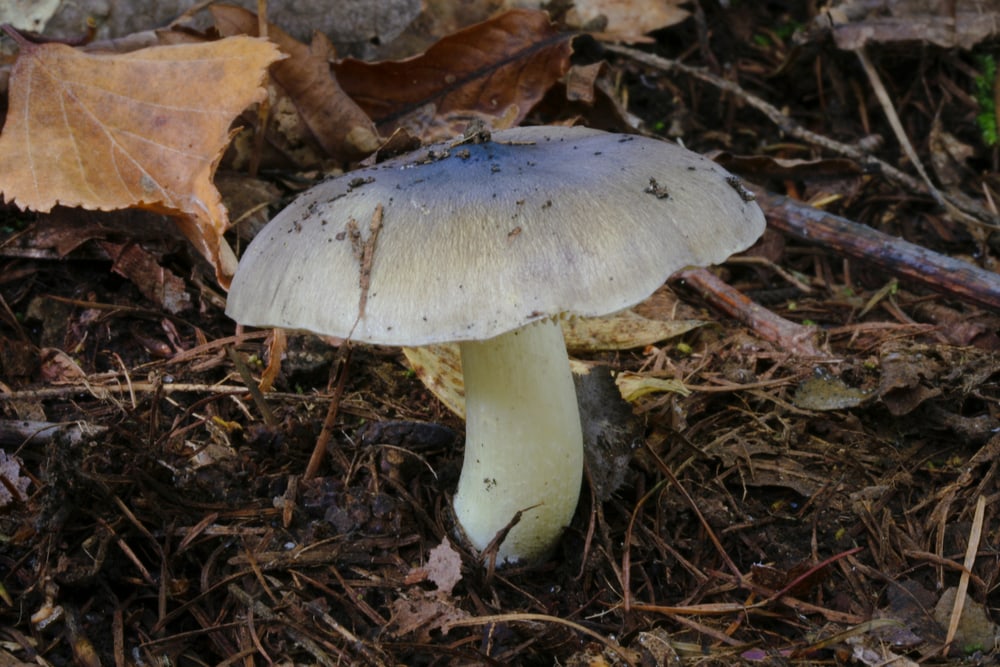
The Sooty Head, also known as the Coalman Mushroom or charbonnier, is distinctive for its gray cap, hence the name. Portentosum translates to “portentous omen” but can also mean marvelous or wonderful.
It has a mild, pleasant taste which is made better by frost. It can be confused with other gray mushrooms which aren’t good for you, so get to know the Tricholoma genus well before eating.
You May Also Like: Are Pine Cones Edible? Discover The Surprising Truth
Collecting Mushrooms
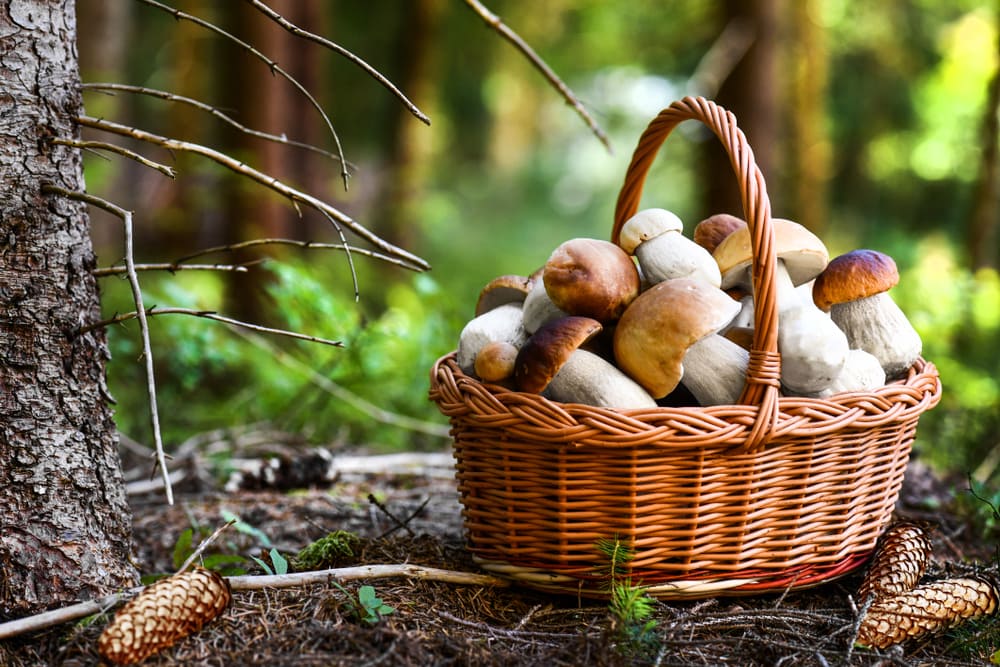
To collect mushrooms, It’s handy to have a wide, flat-bottomed wicker basket, a mushroom knife, and a pocket field guide. You can also bring mesh fruit bags or brown paper bags. Plastic bags, however, turn mushrooms into pulp!
Identifying Mushrooms
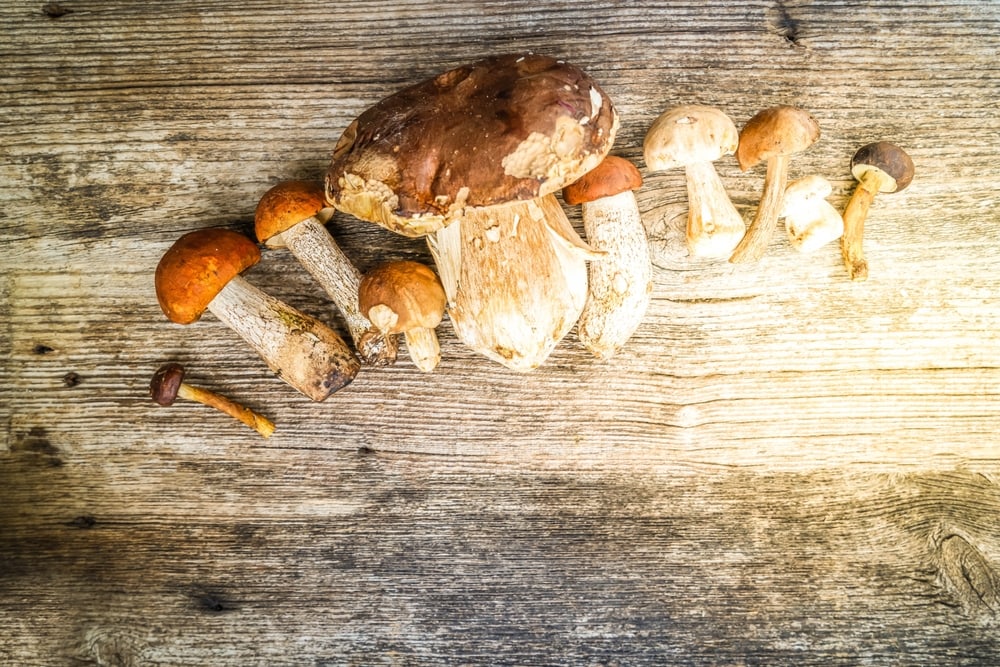
To identify a mushroom, refer to the list below:
- Habitat (grassland, woodland)
- Substrate (tree stump, leaves, soil)
- Closeby trees
- Cap shape and diameter
- Height
- Color
- Texture
- Smell
- Spore print
Taking a Spore Print
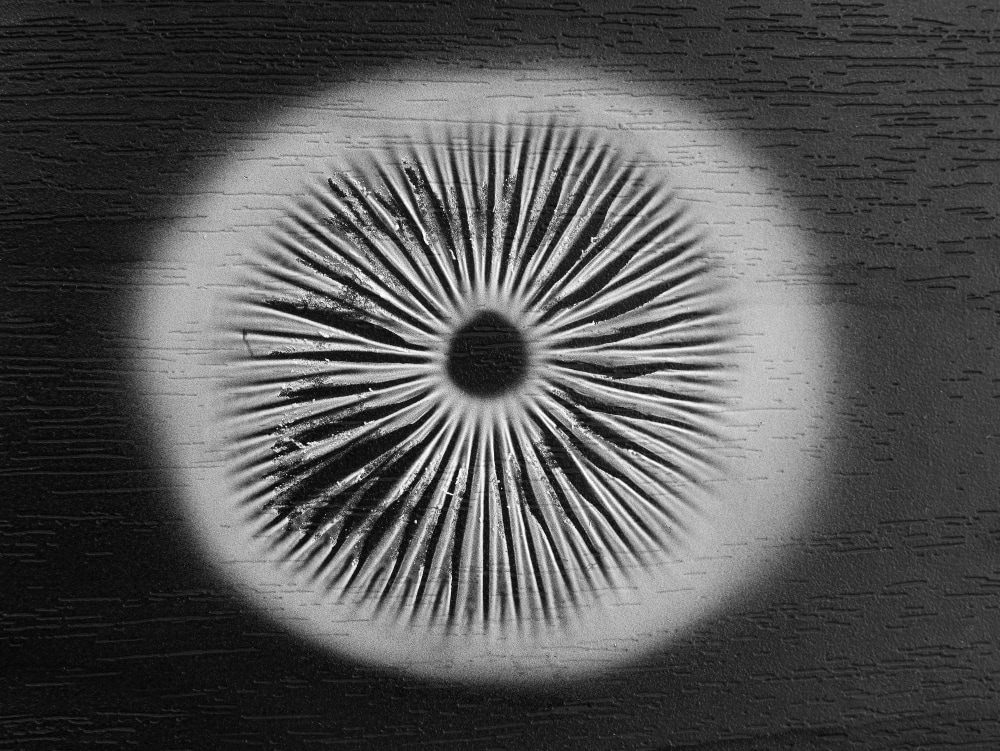
A spore print tells you what color spores a mushroom has. This is a helpful way of identifying a mushroom. They’re really pretty, too!
To take a spore print of a mushroom:
- Cut off a mature, opened cap of the mushroom you want.
- Leave it in a sheltered dark space.
- Lay it on plain colored paper overnight. It can help to put half of the mushroom on top of black paper and the other half over white. The next day you should see a pattern of spores!
Check out this link for more edible (and poisonous) mushrooms!
You May Also Like: Toxic Plants That Look Like Food: 30 Plants You Need To Know
Edible Mushrooms FAQs
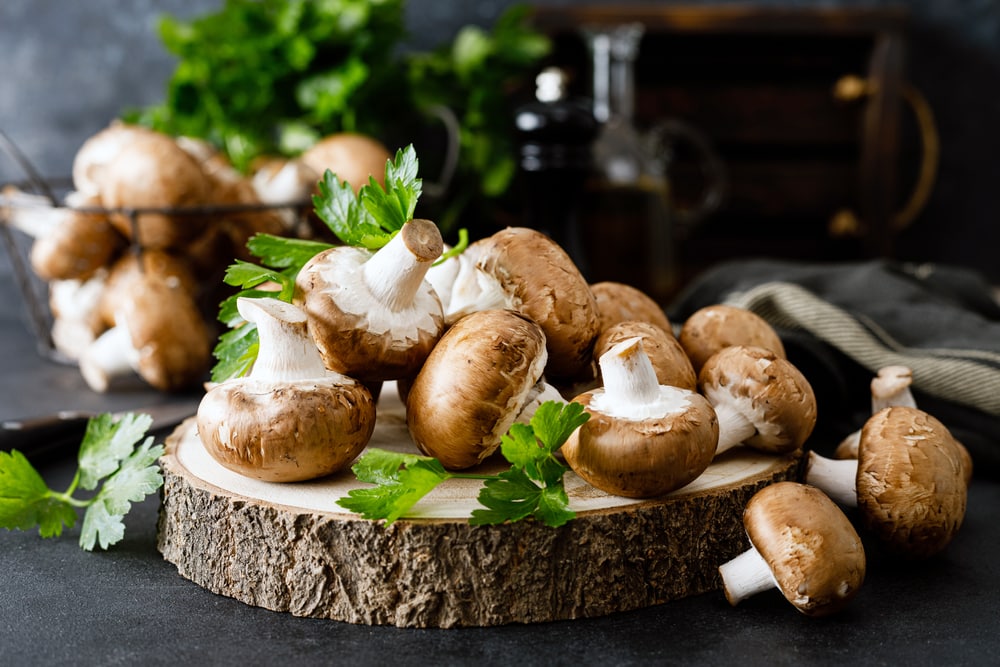
What are the healthiest mushrooms to eat?
Several Japanese mushrooms are known for their health benefits, including the Reishi mushroom.
What is the best tasting mushroom?
Black Truffle is known to have a superb flavor. Chanterelle tastes of apricots. The Cep tastes like roast dinner. All are highly regarded in restaurant culture worldwide.
Are mushrooms with white gills poisonous?
This is a myth. Some mushrooms with white gills are edible, and some are poisonous.
Can you tell if a mushroom is poisonous or edible by its smell?
You can’t always tell if a mushroom is good to eat by its smell. It can be a clue, however. The Yellow Staining Mushroom, which looks like the edible Brown Wood Mushroom, smells a lot like embalming fluid.
Some poisonous mushrooms still smell nice, however. So, don’t use smell as a sure guide.








